




















Jumeirah Golf Estates once again welcomes the DP World Tour’s top-50 players. Page 40

6 Like London Buses They all come at once! It’s the start of the busiest time for golf in the Middle East. by harry grimshaw
8 Greatest On Earth
“The Shark” Greg Norman designed Earth Course will cause drama as always. by harry grimshaw
Undercover
Journeys
14 They Call Him
“Driver Off the Deck” Jim Yong Kim tackles mental health like a par 5 into the wind by jerry tarde
28 Oktoberfest
A look back at the Golf Digest Middle East Oktoberfest. by harry grimshaw
40 The 2024 Race Ends Here…
History of the DP World Tour Championship. by harry grimshaw
42 A Major Mountain McIlroy’s turbulent 2024 looks to finish on a high note in the UAE. by harry grimshaw
44 Gracing Doha International Series is returning to Qatar. by harry grimshaw
46 Hatton Lines Up Asian Tour Finale
The US$5 million PIF Saudi International edges closer in Riyadh. by harry grimshaw
48 Majlis Master Rory McIlroy will be aiming for his fifth Dallah Trophy at Emirates Golf Club. by harry grimshaw
52 Who Was Payne Stewart?
Twenty-five years after the golfer’s passing, a writer remembers unguarded times. by guy yocom
58 Game Changer
How the Big Bertha revolutionised golf. by ely callaway
18 Swing Analysis Byeong Hun An by luke kerr-dineen
20 Rules Of Golf
Yes, the “leaf rule” is a real thing, and it might save you shots this fall. by drew powell
21 Try the ‘Fitz Grip’ Matt has a new way to make more putts. by luke kerr-dineen
22 Pivot Around The Post Focus on your left heel for better drives. by ben griffin
23 How To Avoid A Back-Nine Meltdown Et al officim incimus eosam aut et volest. by sam weinman
25 Check Your Specs Not all irons are interchangeable by e. michael johnson
26 What’s in My Bag Harris Engilsh with e. michael johnson
66 Pack Like A Pro Ludvig Åberg with brittany romano
32 Maintaining A True Desert Links Key changes to Yas Links Abu Dhabi. by jack balfour
33 The Key Holes What to look out for at the Abu Dhabi HSBC Championship. by amy condon
36 Ask An Architect Has the tree removal trend gone too far? by brian schneider
38 The Executive Treatment Abu Dhabi Golf Club is getting a new look. by peter harradine
64 Club News
A gallery of some of the local winners in the amateur circuit.


It’s the start of the busiest time of year for golf in the Middle East, they all come along at once!
BY HARRY GRIMSHAW
WITH TEMPERATURES now perfect in the UAE, it’s all systems go on the golfing front!
We have been waiting patiently for the world’s biggest names in the game to set foot back in the region, and boy have we got a lot to look forward to this month!
With the Ladies Aramco Team Series just wrapping up another successful season over at Riyadh Golf Club in Saudi Arabia, it’s the United Arab Emirates turn to greet the world’s best Male golfers.
In a new-look DP World Tour season, the inaugural DP World Tour Play-Offs are set to welcome the 70 highest-ranked available players on the Race to Dubai Rankings, to Yas Links on November 7-10 for the Abu Dhabi HSBC Championship. Then, the top 50 available players battle it out at the DP World Tour Championship at Jumeirah Golf Estates’ Earth Course on November 14-17, where the DP World Tour’s season-long Race to Dubai champion will be crowned. (Don’t be surprised if it’s Rory, he’s going for his sixth Harry Vardon Trophy!)
Already confirmed to be competing across both Rolex Series events are some of golf’s biggest talents, including Dubaibased Tommy Fleetwood, Rory McIlroy, Justin Rose, Shane Lowry, Adam Scott and Robert MacIntyre, while Billy Horschel, who recently claimed his second BMW PGA Championship title, will also be teeing it up at in the season-ending tournament.
Being played alongside the DP World Tour Championship is the G4D Tour Series Finale @ Jumeirah Golf Estates, where Golf Saudi ambassador Kipp Popert will be looking to make it win number five of the season to cap off another remarkable year for the Englishman. His closest rival is Ireland’s Brendan Lawlor on the year-long order of merit.
There is still more to keep an eye out for!
The Asian Developmental Tour have their season finale, the Aramco Invitational Tournament, at Rolling Hills Golf Course in Saudi Arabia to look forward to at the end of the month, where the top five players on the order of merit will receive a full Asian Tour card for 2025.
Staying with the Asian Tour, they are having their penultimate event on the 2024 International Series billing in the Qatari capital of Doha, for the US$2.5 million prize pool event. Doha Golf Club will welcome the likes of Dubai-based Indian Anirban Lahiri, England’s Sam Horsfield, Ryder Cup star Thomas Pieters and American Peter Uihlein.
What a line-up we have this month!
There is plenty more on all the above inside, hope you enjoy!

editor-in-chief Obaid Humaid Al Tayer
managing partner & group editor
Ian Fairservice
chief commercial officer
Anthony Milne
editor Harry Grimshaw
art director Clarkwin Cruz
editorial assistant Londresa Flores
publisher David Burke
general manager - production
S. Sunil Kumar
production manager Binu Purandaran
THE GOLF DIGEST PUBLICATIONS
editor-in-chief Jerry Tarde
senior director, business development & partnerships
Greg Chatzinoff
international editor Ju Kuang Tan
GOLF DIGEST USA
editor-in-chief Jerry Tarde
general manager Chris Reynolds
editorial director Max Adler
executive editor Peter Morrice
art director Bill Specht
managing editors Alan P. Pittman, Ryan Herrington
playing editors Collin Morikawa, Jordan Spieth, Bubba Watson
dubai
Email: motivate@motivate.ae
4 390 4845
abu dhabi
14th Floor, Office 1406, Makeen Tower, 9th Street, Al Zahiyah, PO Box 43072, Abu Dhabi, UAE Tel: +971 2 677 2005; Fax: +971 2 657 3401
Email: motivate-adh@motivate.ae
saudi arabia
Regus Offices No. 455 - 456, 4th Floor, Hamad Tower, King Fahad Road, Al Olaya, Riyadh, KSA Tel: +966 11 834 3595 / +966 11 834 3596
Email: motivate@motivate.ae
london
Motivate Publishing Ltd, Acre House, 11/15 William Road, London, NW1 3ER, UK
Email: motivateuk@motivate.ae
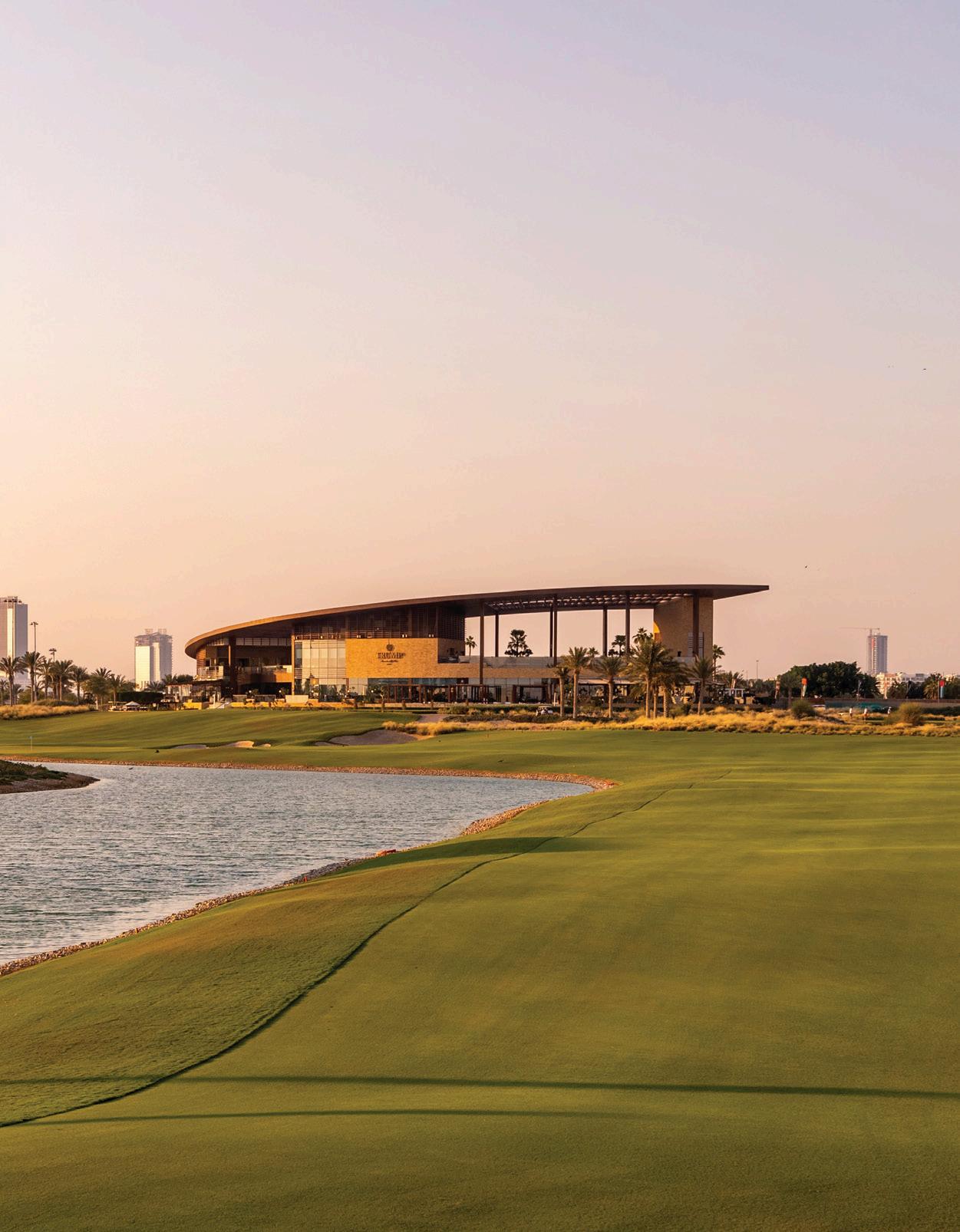
Your World- Class Golf Ex perience
Discover the ease and luxury of booking tee times, managing reservations, real-time updates, and accessing exclusive offers – all from the Trump Golf Dubai App. Available now on iOS and Android.



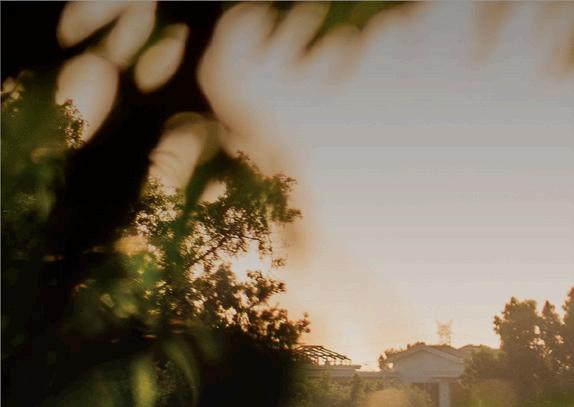
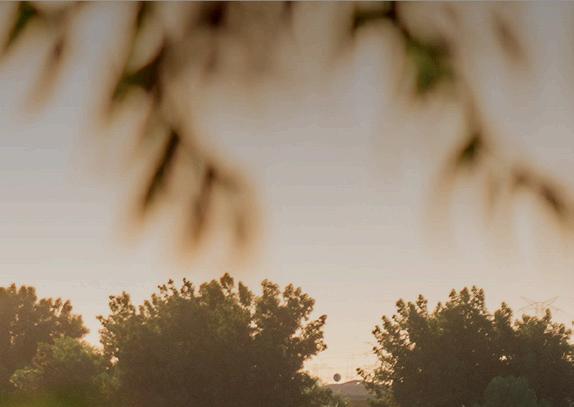



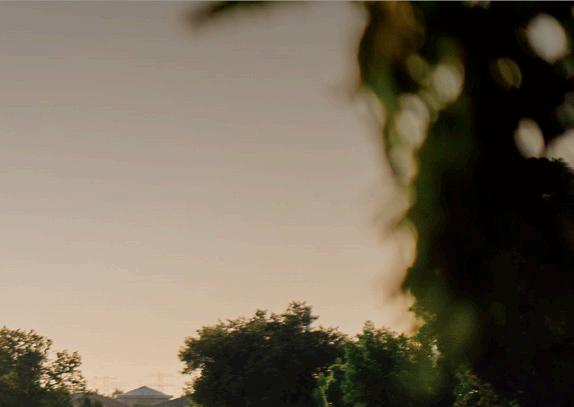


Since 2009, the Earth Course has played host venue to the DP World Tour’s season-ending DP World Tour Championship, Dubai
BY HARRY GRIMSHAW
THE EARTH COURSE is one of Jumeriah Golf Estates’ two championship golf courses designed by the “The Shark” Greg Norman in Dubai.
The bigger brother of the two 18 holes at Jumeirah Golf Estates, measures over 7,600 yards from the tips, and the Earth Course greets you with 18 holes of its gorgeous green fairways, tree bark flanked rough and piercing white bunkers.
Each hole on the Earth Course was designed by The Shark to blend into the surrounding landscape, with the world recognised 18th hole fairway split up its entire length by the creek built to (and successfully) gather many a golf ball into a watery grave.
Since 2009, the Earth Course has played host venue to the DP World Tour’s season-ending DP World Tour Championship, Dubai, where each year the event welcomes the Race to Dubai’s top 50 golfers to battle it out for the DP World Tour Championship title and the crowning of the Harry Vardon Trophy.
This month will see the likes of Rory McIlroy, Billy Horschel, Tommy Fleetwood, Robert MacIntyre, Shane Lowry and plenty more teeing it up in the UAE.
Why don’t you turn to page 40 to read more about it!


Handshake deals with tour pros are sketch

WH EN YOU’RE IN THE
“real world” and somebody doesn’t pay you for a service provided, your options are straightforward. Send a letter or two, knock on some doors and maybe even file a lawsuit.
It will probably come as no surprise that professional golf at the top level is not the real world.
My central income has always been teaching regular, recreational players, probably like yourself. Coaching tour players used to be a nice-to-have bonus, but now it can be life-changing if the player is at the very top. If I’m getting paid a percentage—I’ve seen coaches take anything from three percent to 10—and your player has a top-10 season on the PGA Tour or LIV, we’re talking seven figures.
That’s serious business.
The gusher of money that has come into the game over the last few years has made the deals between players and coaches much more formal. Players like Tiger Woods have long had contracts with coaches (complete with non-disclosure agreements), and that practice is now spreading. A big-time golfer nowadays already has an agent in college for NIL deals, and is teeing it up for the first time as a professional with an equally professional team of contracted subcontractors in place.
But what happens when it’s not quite that clean? When nothing is written down, and you’re counting on a handshake from somebody with a generally good reputation?
I found out the hard way.
I knew one player casually through mutual friends. When he was going through some particularly bad struggles, he texted to see if he could come see me during an off week at my home club. I was happy to look, and he paid me my normal full day rate at the end of the afternoon with a personal check.
The next few weeks he played better, and he texted to see if I would be willing to work with him regularly. The next time we met up, I told him my normal deal—a retainer up front against expenses and four percent of earnings, paid monthly. He said that sounded good and it would be taken care of
shortly. We worked for two more full days, and he left to play in some events overseas where I wasn’t traveling.
Fast forward a month and some great finishes—and plenty of exchanged texts, swing videos and remote range sessions— and I thought I’d be getting a five-figure wire transfer.
Instead, I got a series of increasingly vague texts that ended with one where he said he had gotten some good stuff from another coach, and we’d maybe get together again down the line sometime.
As a golfer, if you become known as a guy who doesn’t pay off his bets, you quickly become a solo artist during practice rounds. The same solidarity doesn’t exist among coaches. Confronting a player directly about money at an event would be a quick way to cost yourself opportunities to work with other players. And there’s a zero percent chance other coaches would hear of somebody getting stiffed by a golfer and then refuse to work with that golfer out of a sense of principle.
Fact is, I don’t teach from high ground. I’ve worked with players who are known to be tight with money or have a (deserved) reputation for being jerks to tournament staff, abusive to caddies and hard on coaches. It’s one thing to talk tough about your morals when you’re watching something on TV, and another when you might have the chance to put your kids through college if a player you coach makes it to the Tour Championship.
Money talks. Just ask the guys who went to LIV. Or their coaches. Making $4 million for winning a three-round event is nice work, as is collecting six figures for doing the coaching.
The next time I saw the player who stiffed me, I was on the range at an event working with another client. I thought it might be awkward, but it certainly wasn’t for him. He shook my hand and asked me how everything was going. I’m not ashamed to say I acted like nothing was wrong and wished him luck that week.
And if he texted me tomorrow asking for a look, I’d say yes.
I’ ll just make sure I get things in writing —WITH











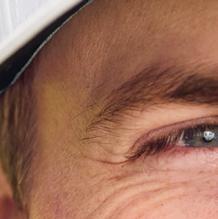













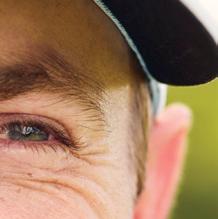













I had one college semester left but thought it’d be easy to make it on tour. Now as a winner, I realise how wrong I was
BY JAKE KNAPP WITH KEELY LEVINS
WHEN I WAS GROWING UP, MY GRANDPARENTS LIVED ON A course in Palm Springs, so I played a lot of golf with my grandfather. He was a big part of my career, and I texted him after every event. After he died in 2023, I kept texting his number, telling him how I did. I hope he somehow got the message I sent him after my first PGA Tour win.
My dad and mum worked 9-to-5 together at a printing company. My brother and I walked to the public course, Costa Mesa, across the street after school. There weren’t many other kids playing there, so we played with guys on the local community college team and guys spending too much time at the bar. My brother and I took lessons from the pro, John Ortega. He’s still my coach today.
●
●
●
JAKE KNAPP
PGA TOUR
AGE: 30
LIVES: SCOTTSDALE
I was small, so I wasn’t the longest hitter. I focused on my short game. I also joined a grungy gym full of oldschool guys lifting. I got really into it. When I grew six inches between freshman and sophomore year of high school, I suddenly had a well-rounded game.
●
●
●
I played basketball, baseball and football, but I knew I was better than most kids at golf. I could shape shots when others couldn’t. After my freshman year, I decided to focus on golf. We didn’t have the money to travel far for tournaments, so we picked events that were drivable or near friends that we could stay with to save on hotel costs.
●
●
●
I went to UCLA, where the academics are no joke. If I’d gone somewhere else, I would’ve had an easier academic experience and more time to practice. I worked hard in school and practiced and lifted as much as I could. Looking back, I should’ve focused on longevity rather than size in the gym
After the fall of my senior year in 2015, I wanted to leave school. That summer, I’d qualified for the U.S. Open and finished third in stroke play at the U.S. Amateur. I didn’t have status anywhere, but I felt ready, so I left college with one semester to go. My parents, who were helping to pay my tuition, were OK with my decision, especially after I argued, “You can stop paying, and I can start earning.” I thought everything would fall into place. I know now that I was too impatient.
● ● ●
Canadian Tour Q school was the first time I felt an insane amount of pressure in golf. My parents let me leave college, so if I don’t make it through, I’m going to be a complete failure. I didn’t make it. I was devastated, but I was living at home and had enough sponsorship money to play in Monday qualifiers. In 2017 I went back to Canadian Tour Q school and won by seven shots. Then, some back issues flared up. I think they were from overworking in the gym.
● ● ●
I came back in 2018, played terribly and lost my status. I’d been a pro for three years and hadn’t had any real success. Frustrated, I played some pickup basketball and seriously sprained my ankle. I thought about quitting. The injury would heal, but I was out of money. Then a generous member at my club stepped in and supported me. I decided to keep going. I focused less on distance and more on accuracy off the tee, and
it helped. I won twice on the Canadian Tour and got Korn Ferry status for the 2020 season. I was finally in a groove, then COVID hit.
● ● ●
In 2021, I tried to change my swing to become a better wedge player, but I couldn’t make the new moves. I learned that you don’t need to change your swing, you just have to own what you do. I struggled that year. I spent the last of my money on Q school and didn’t get through. I had opened up a lot of credit cards, so I needed a side hustle.
● ● ●
While interviewing to be a barback, a bar in Costa Mesa called The Country Club asked if I would do security. It wasn’t a rowdy place, so I wasn’t too worried about getting hurt. Most of the time you’re just checking IDs. Once in a while, you’re dealing with guys who need to go home. I enjoyed it.
● ● ●
I spent a few months practicing all day and working at night. I got my Korn Ferry status back for 2023, when all the work I’d been doing finally showed up. I had 10 top-10 finishes and earned my PGA Tour card. It didn’t happen as fast as I thought it would when I was a 21-year-old kid dropping out of college, but I was right. I made it to the tour.
●
The PGA Tour is a big circus. There are always eyes on you, the courses are harder, and Rory, Scottie and Xander are in the field. I remind myself that I’ve earned it. I won in Mexico in just my fifth tournament in 2024. I still haven’t processed it. I brought my family and friends to the Masters, but one person was missing. My grandpa would’ve loved to have seen me play at Augusta. One day, I hope I text him to let him know that I made a Ryder Cup team.

Jim Yong Kim tackles mental health like a par 5 into the wind BY
JERRY TARDE
Ihave the unlikeliest golf friend that you need to meet, because a round of golf with him will change your life. Or at least inspire you to look at the world differently.
Jim Yong Kim was born in 1959 in Korea, one of the poorest countries in the world at the time. His father was a dentist, and when Jim was 5 years old, his family moved to Muscatine, Iowa, right next to a golf course. That’s where most good stories begin. He started
playing at nine years old and got down to scratch. “I loved the game, just crazy about it,” he says.
I’ll have to cut short his resume, but to give you an idea, he was president of his high school class, quarterback of his football team, point guard on his basketball team. He went to Iowa, Brown and Harvard; got degrees in medicine and anthropology. Founded Partners in Health with Paul Farmer and saved millions of lives in Africa, Haiti and Peru through tuberculosis and HIV
treatments. There’s a movie about what they did called “Bending the Arc.” He earned a McArthur Genius Fellowship and served as president of Dartmouth College. “His personal story exemplifies the great diversity of our country and the fact that anyone can make it as long as they’re willing to work hard and look out for others,” said President Obama when he successfully nominated Jim for the presidency of the World Bank (2012-2019). He’s now chancellor of the University of Global Health
Equity in Rwanda. And his golf handicap fluctuates between 3 and 5.
“Everything about golf I find interesting,” he says. “I watch it all the time. I think about it. I’m a tinkerer. I try all the training aids. You know they don’t all help, but the hopefulness of getting better is what I love about golf. I’m a physician. I’ve focused my entire life on trying to help the poorest people in the poorest countries. But also at heart, I’m a competitor and this game is the only thing I can still compete at now. There are so many angles of how you control your mind, get your body in shape, the social opportunity to meet people; everything about it I find compelling.”
Jim’s latest initiative is in the field of mental health. I reached out to him when Grayson Murray took his own life during the Charles Schwab Challenge on the PGA Tour this year. (Jim Nantz told me it was the hardest sporting event he’d ever covered: “We just wanted it to end,” he said.) Other professional golfers like Matthew Wolff, Lexi Thompson and Bubba Watson have been increasingly open about their mental health struggles, and no athlete more than 7-time Olympic gold medalist Simone Biles. Jim pointed me to a groundbreaking book by Robert Putnam in 2000 called Bowling Alone: The Collapse and Revival of American Community, which details how disconnected we’ve become from friends, family, and democratic structures.
“One of the biggest reasons we have such mental health problems,” says Jim, “is people spend so much time on their smartphones and especially on social media. Experiments have proven if you take away smartphones in schools, anxiety and depression levels drop dramatically. Social media is especially toxic for young people. So golf is a great way to get off your phones, have real social interaction and get a healthy dose of sunlight— what has been called ‘ecotherapy.’”
“Another downside of modern culture is the way myopia (nearsightedness) has gone up. Fifty years ago, the level of myopia was about 25 per-
cent in the U.S. Today it’s 42 percent. In Singapore, China and Japan, the rate of myopia in high school graduates is over 80 percent and in Korea 96 percent of 19-year-old men are myopic. According to experts, these high rates of myopia are likely due to heavy exposure to electronic devices at a young age and less exposure to outdoor sunlight. [Maybe another good reason to limit the use of smartphones and apps on the golf course—it’s our four hours of tranquility.] Golf is, in so many ways, an antidote to the problems we’re seeing with social isolation and loneliness, both physical and mental. Depression is the largest cause of lost productivity in any workplace. Did you know that if you’re lonely, it shortens
conversation about mental health and know when to escalate the interactions to a professional. Jim’s goal is to bring to all colleges and universities a training system that’s similar to the way students are taught about alcohol abuse or sexual assault.
“Golf is, in so many ways, the antidote to the problems we’re seeing with social isolation and loneliness, both physical and mental.”
your life expectancy as much as smoking 15 cigarettes a day?”
Jim says what’s getting better is that people are willing to talk about it. In the U.S. there are more than 700 million therapeutic interventions every year. But still, not everyone can get an appointment with a professional therapist and it’s expensive. He again cites South Korea as having the highest suicide rate of all major countries with 25 to 35 percent of Koreans suffering from depression and only 2 or 3 percent getting treated because it’s so stigmatized. Suicide is the second leading cause of death among Americans ages 10 to 14 and 25 to 34, and for those ages 15 to 24, it’s third. Those should be unacceptable statistics.
Jim has become an advocate for what’s called “psychological first aid.” It starts with the simple question: Are you OK? The World Health Organisation has a protocol teaching young people how to ask the right questions, normalise
“If we can get one or two key schools to get really serious about suicide prevention and teach all their students psychological first aid, my hope is that everyone else will want to follow,” he says. “There was no greater stigma than HIV when there was no treatment available and then everything changed after we witnessed the ‘Lazarus effect’ of highly effective HIV medicines. Mental health has always been one of the most stigmatized illnesses and while the treatments are not as powerful as the medicines for HIV, there are many newer, more effective therapies that just aren’t getting to the people who need them. We can do better and prevent the kind of suffering that Grayson Murray experienced.”
Golfers afford many worthy charities and noble causes, but the unique nature of our game gives us opportunity and resources to become a beachhead in the fight against mental illness. Golf should stake out a claim to be part of the solution by talking openly about the issue, providing support to those who need it and by introducing programs like psychological first aid so no one will be missed. “Please honour Grayson by being kind to one another,” his parents said.
“It feels like HIV back in the early 2000s when we were fighting to get treatment to people in poor countries, especially Africa,” Jim says. “In mental health we need better treatments and better systems to deliver them, but there is so much we can do right now to recognise the signs of depression and suicidality and get people the help they need. Isn’t it worth doing everything we can to listen to Grayson’s parents and prevent more tragedies?”
Obama has a nickname for Jim—he calls him, “Driver Off the Deck”—for his aggressive proclivity to hit driver from the fairway to reach par 5s in two. If there’s a golfer who can pull off this shot, it’s the extraordinary Jim Yong Kim.








EDITED BY RON KASPRISKE

“To create a balanced, dynamic posture for a proper swing, pretend you’re surfing. Shift your left hip toward the target and your sternum away from it. For a surfer, this prevents a wipeout. In golf, it keeps you from reverse pivoting or swaying as you take the club back.”
-Golf Digest 50 Best Teacher in America
JASON BAILE





Byeong Hun An’s swing indicates ‘major’ potential
BY LUKE KERR-DINEEN
BYEONG HUN “BEN” AN HAD just built a new house and become a first-time dad. His personal life couldn’t have been better. But then following the 2020-’21 PGA Tour season, he lost his tour card. It was a devastating blow for a man who in 2009—at age 17—became the youngest player to win the U.S. Amateur.
Not sure what to do, An contemplated taking some time off. His coach, Sean Foley, whom An had hired just a few months earlier, thought it was time for a frank conversation.

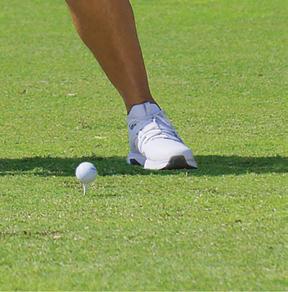
“I said, ‘Benny, it’s time we’re deeply honest with each other. Your attitude hasn’t been good enough,’ ” says Foley, who has coached several top tour pros including Tiger Woods. “I told him, ‘For the next three months we’re going to do banker’s hours, 9 a.m. to 5 p.m., six days per week. That’s your schedule. And if I hear that you don’t do it, I’ll quit.’ ”
An’s reaction? “It wasn’t easy to hear. But I needed to hear it.”
It’s no coincidence that An, a native of South Korea, is an athletic prodigy.

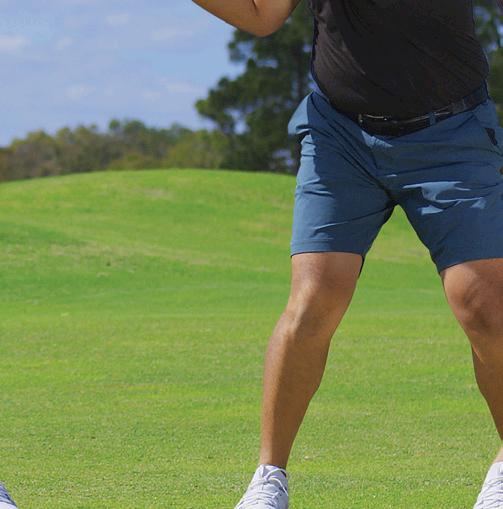



His parents are Olympic medalists in table tennis, and his dad coaches the South Korean women’s national team. Good genes in part blessed An with an incredible set of hands and coordination, which shines around the greens.
Unfortunately for him, those hands can be a curse on longer shots. An’s ability to hit sharply down on the ball and flick his wrists for maximum greenside spin would often cause him to get steep on his full swing. His drives would often balloon out to the right, robbing him of valuable distance and accuracy.
When he showed up to the range the day after his talk with Foley, the pair focused on getting An’s arms wider on the backswing with less wrist hinge (above, third image). This helped An rotate his body more on both sides of the ball—and helped quiet his wrist action. It also repositioned his right arm at the top of the backswing so that he could throw the club down on a shallower, more sweeping plane into the ball (fifth image).
By generating less uncontrollable spin with his hands and more speed from his

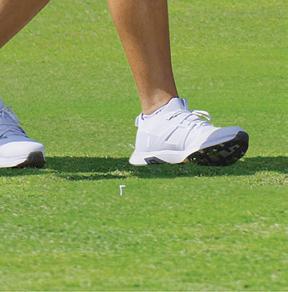
body’s rotation, An added more than 12 yards to his drives—through mid-August, he ranked fourth on the PGA Tour at 315 yards. Aided by a 30-pound weight loss (he’s 230 pounds now) and much better overall fitness, he also jumped to 23rd in strokes gained/off the tee. An’s clubhead speed now approaches 120 miles per hour, and he has a new go-to shot—a high, flat draw which Foley calls “the weapon.”
“It definitely sounds cool,” An says of the new swing shape. “It’s been a lot of hard work, so I’ll take it.”

You know your ball is in there somewhere—and you’ve got options
BY DREW POWELL
EACH AUTUMN , GOLFERS invoke the “leaf rule” to lobby for a free drop when they can’t find their ball under a pile of foliage. Some use it as a concession to appease a frustrated opponent. Others claim it as justification for avoiding their own lost-ball penalty, emphatically asserting the Rules of Golf supports it.Is it an official rule? Yes, in some instances. It takes some explaining.
Irrespective of the official rules, the act of taking a free drop after losing a ball in a spot where it should be found seems logical. Why should you receive the same penalty as someone who just sliced one out-of-bounds?
Unfortunately, in many cases the rules are not so lenient. Rule 18.2 states that “your ball is lost if not found in three minutes after you or your caddie begin to search for it.” When a ball is lost, you
must take a stroke-and-distance penalty (and a penalty stroke) and play from the spot of your previous shot.
Proponents of the leaf rule, however, often cite Rule 16.1, which allows a player to take free relief from a ball not found when it is “known or virtually certain” it came to rest in or on an “abnormal course condition.” This is where things get a little grey. Leaves are considered an abnormal course condition only when they are intentionally piled for removal outside of a penalty area. If that’s the case, and you either saw the ball enter the leaves or are virtually certain it did (maybe someone else saw it), then you are entitled to a free drop by finding the nearest point of complete relief and dropping within one club-length, no closer to the hole.
A more common scenario is when leaves are scattered or pile up naturally.
They are not considered an abnormal course condition. They are simply loose impediments, so you are not entitled to free relief if you’re sure your ball is lost under them.
Hope is not lost, though, as you may be entitled to free relief under Model Local Rule F-14, which a tournament committee or course staff implements.
“Piles of loose impediments such as leaves, seeds or acorns might make it difficult for a player to find or play his or her ball,” the rule states. “A Committee can choose to treat such piles in the general area or in a bunker as ground under repair from which free relief is allowed under Rule 16.1.”
Be sure to check with the course about this local rule before heading out.
Are piles of leaves loose impediments or an abnormal course condition?


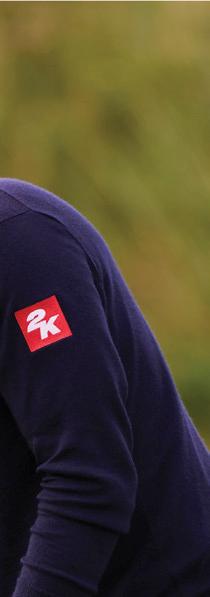

Matt, and some other pros, have a new way to make more putts
BY LUKE KERR-DINEEN
T RADITIONALLY, MOST golfers putt with the standard reverse-overlap grip. They curl their lead finger over the pinky and ring fingers of the dominant hand. However, more and more tour pros are ditching the traditional overlap, instead choosing to extend the lead finger of their lead hand (left finger for right-handed golfers) straight down the grip, like you see Matt Fitzpatrick doing here (right).
Among the other players doing this now are Tommy Fleetwood, Justin Rose, Nick Taylor and Matt Wallace.
“It tends to firm up the lead wrist, which will reduce hinging and promote better face control,” says Bill Smittle, a putting coach and one of Golf Digest’s Best Teachers in North Carolina. “It also brings your hands closer together and your wrist joints into alignment. It means your forearm plane is more neutral. When one hand is lower than the other, whatever hand is on the bottom is usually more extended, which then puts your forearms out of alignment.”
BRACE FOR IMPACT
The left wrist needs to be firm for a true roll.
When your left finger is extended down the grip, your left wrist starts to feel like a wall, Smittle says, and you can release your right hand as much as you want in the through-stroke without worrying about it sending the ball off line. In fact, it really doesn’t matter how you hold the putter with the right hand when using this style, including the “claw” and “paintbrush” methods. The left hand remains in complete control, Smittle says, and that’s key to sinking more of those mid-range putts.

Focus on your left heel for better drives
BY BEN GRIFFIN
THE LAST THING YOU want to do is try to steer your driver in play, but on the flip side, if your swing gets too loose, you risk hitting the ball off the map. So how do you find the balance between being too restricted and too wild? The key might be your left foot.
When my driver just isn’t working, it’s often because my left foot is spinning out as I swing down. I’m rotating my
body pretty fast to get through the ball, and my toes go from facing the ball to facing the target. It’s an unfortunate byproduct of trying to generate more power, and I see a lot of amateurs making the same error. There’s nothing wrong with having good body rotation—at least you’re not steering with the arms only—but you have to control it.
To help stabilise my lower body, I spend a lot of time with my trainer, Randy Myers, working on balance and one-legged exercises. I also focus on my lead foot—in particular my left heel— and I think that work can help your ballstriking, too. —with ron kaspriske
BEN GRIFFIN joined the PGA Tour during the 2022-’23 season, and finished second at the RBC Canadian Open this past June.

The more you can rotate your body in control, the more fairways you can hit. For me, the key is that my left foot, particularly my left heel, stays grounded as I swing down (above). Mine eventually lifts a touch (left), but not much. When you go to the range, hit your driver with the thought of keeping that heel down. Feel like your body is pivoting around it and that pressure is moving upward through that leg. That’s how to swing harder without spinning out.

There’s science behind why you make dumb decisions after the turn—but you can do something about it
BY SAM WEINMAN
ASTUDY BY THE FRENCH Institute of Health and Research explored how cognitive thinking is impacted when your brain has been sufficiently taxed. Its testing revealed that an overworked brain is no different than cramping leg muscles in the final miles of a marathon—the simplest tasks become arduous. “The cerebral gears start slipping and impulsiveness kicks in,” a summary of the study said. If you play a lot of golf, this should come as no surprise. Floundering on the back nine is a tale often told over drinks at the 19th. It happens to the pros, too. Rory McIlroy’s putting mishaps on Sunday at the U.S. Open could be chalked up to brain fog. Prior to the first of two misses inside of four feet in the closing holes, he had made 496 consecutive putts from three feet and in. Also, don’t forget that Phil Mickelson double bogeyed the 18th hole to lose the 2006 U.S. Open and Jordan Spieth put two shots in the water on the 12th hole to surrender a commanding lead in the 2016 Masters.
DEJECTION
Jordan Spieth blew a fiveshot lead on the back nine at the 2016 Masters.
Coincidences? Maybe. But their personalties and the situations at hand seem to support the study’s findings. McIlroy, Mickelson and Spieth are three of the more cerebral pro golfers and each was faced with a complex assortment of challenges. McIlroy was closing in on his first major title in nearly a decade. Mickelson had meticulously analysed every hole at Winged Foot in search of his first U.S. Open. And Spieth was trying to extend a streak of seven consecutive rounds with the lead at Augusta while also clearly fighting his swing.
So what can you do to avoid crashing like them on the back nine? Here are five helpful tips.
1. Your conditioning matters
The better your fitness, the less likely fatigue will cloud your decisions. “Give yourself a chance to not be as gassed as early as you would be,” says Selena Samuela, a Peloton instructor and golffitness trainer. “If you’re tired by the 12th hole, you’re in a battle with yourself.”
2. Build in breaks
A stressful round doesn’t need to be stressful the whole time, says Matt Cuccaro, a golf performance coach: “Whether it’s being social or enjoying the environment, anything that takes you out of the task and be lighter is going to help you stay fresh.”
3. Rely on sound fundamentals
Stress compromises your swing. Golf Digest Teaching Professional Michael Breed says understanding the basics of your setup (posture, grip, alignment) gives you something to rely on when things get foggy.
4. Conserve brain power
Don’t get bogged down by stuff that is out of your hands, Cuccaro says. For example, focus on where you want the ball to start, not finish. “The finish is largely out of our control,” he says.
5. Be your own caddie
Just knowing your decision-making isn’t great at the end of a round allows you to prepare, Cuccaro says. If you were your caddie, what would you be telling yourself in these fatiguing moments to avoid a meltdown?
EDITED BY PETER MORRICE

This is not a spaceship. It’s a 7-iron. Cobra’s LIMIT3D irons use a 3-D printing process that “grows” a muscleback iron shape from steel powder, replacing the solid steel in the middle with a lattice structure that joins the front and back walls. The idea is to save weight, add stability and boost speed, all while maintaining the feel of a forged blade. ($3,000, 4-iron through PW)
BY E. MICHAEL JOHNSON
A golfer is looking at some new irons from a different manufacturer than he or she is currently playing and is pondering whether the specs (lengths, lofts, lie angles) are the same or different.
It’s highly unlikely they would be the same. As many in the industry like to say, the only thing standard in golf equipment is that there is no standard. Take these 7-irons from the Golf Digest Hot List Players-Distance category:
TAYLORMADE P•790: 30.5 degrees loft, 62.5 degrees lie angle, 37 inches in length
PING I530: 29 degrees loft, 62 degrees lie angle, 37 inches in length
COBRA KING FORGED TEC:
29.5 degrees loft, 62.5 degrees lie angle, 37.25 inches in length
Those might not seem like big differences, but they matter. If you’ve ever gotten fit for clubs, you know that 1.5 degrees of loft is significant, and so is a quarter-inch in length or a half-degree lie angle. Plus, this is just talking about staying with irons in the same category. The differences are more pronounced if you’re changing categories or looking at a blended set of irons with two or more models. Here are three of the more popular Players irons:
TAYLORMADE P7•MC: 34 degrees loft, 62.5 degrees lie angle, 37 inches in length
CALLAWAY APEX PRO: 33 degrees loft, 62 degrees lie angle, 37 inches in length
COBRA KING TOUR: 32 degrees loft, 62 degrees lie angle, 37.25 inches in length
As you can see, if you’re switching from Players irons to the Players-Distance category, the lie angle and length






SAME BUT DIFFERENT
These two Callaway 7-irons differ in loft by 5 degrees.
don’t change all that much, but your loft could be changing by as much as 5 degrees. That’s an important consideration. Although stronger-lofted irons use other means to help get the ball in the air, like a lower center of gravity, some players still have trouble launching them, particularly in the low irons. The reason might not be your shortcomings as a ball-striker but that your irons have too little loft.
We would be remiss if we didn’t look at the Game -Improvement category. The skill level for those who gravitate to these clubs tends to be a tick less, yet the lofts are the stronge st, and some






companies produce clubs with a more upright lie angle to help produce a draw bias. Some iron specs to consider:
CALLAWAY PARADYM AI SMOKE: 28 degrees loft, 62.25 degrees lie angle, 37.25 inches in length
PING G430: 29 degrees loft, 62 degrees lie angle, 37 inches in length
COBRA DARKSPEED: 27 degrees loft, 63.5 degrees lie angle, 37.25 inches in length
Again, the lofts differ greatly from the other categories, and some of the lie angles vary significantly. The takeaway here is just as we stated in the beginning: The only standard is, there is no standard. Ask questions about the specs, and you’re likely to walk away with a set of clubs better suited for you.


AGE 35
LIVES
Sea Island, Georgia. STORY
Has won four PGA Tour events. Member of 2020 U.S. Ryder Cup team.
THE ANSWER IS?
I’m a “Jeopardy!” fanatic, although I don’t watch it as much now that we have a one-year-old.
I just like trivia. I don’t know all the answers, but it’s fun to blurt out random stuff and sometimes be right. I like science, math or U.S. geography questions. But, man, when they go to the Opera or Shakespeare plays, I know I’m done.
—WITH E. MICHAEL JOHNSON
CLUB YARDS * Driver 295
3-wood 265
3-iron 237
4-iron 222
5-iron 210
6-iron 198
7-iron 185
8-iron 170
9-iron 155
46˚wedge 140
52˚wedge 125
56˚wedge 115
60˚wedge 100
* Carry distance

SPECS Ping G430 LST, 10.5°, Fujikura Ventus TR Blue 6-X shaft, 45 inches. I don’t spin my driver that much, so I have to play a little higher loft since this is a lower-spinning head. It’s been an evolution over time. In college, I played 9 degrees but as the ball spun less over time, I had to reevaluate and go up in loft. I also love the acoustics of this driver. The powerful sound fits what I like to hear.
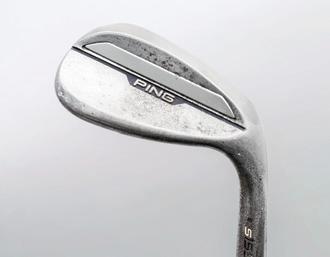
SPECS Ping s159 (46°), True Temper Dynamic Gold Tour Issue X100 shaft; 52°, 56°, 60°, True Temper Dynamic Gold Tour Issue S400 shafts. The pitching wedge matches the rest of my wedges. I do that because I use it around the green more than most. I like to play bump-and-run a lot. It has a little better feel as well. I’ll go back and forth on the bounce with the 60-degree wedge, depending on course conditions. If the turf is firm, I prefer less bounce.

SPECS Ping G400, 14.5°, Fujikura Atmos Blue 7-X shaft, 42.75 inches. This is an older model. I tend not to change clubs a lot. The 3-wood is one of the hardest clubs to change because we’re hitting it off the ground and hitting it off the tee. I also want enough spin where it stays in the fairway as well as the ability to work it on a dogleg. This club checks all those boxes, so why change?
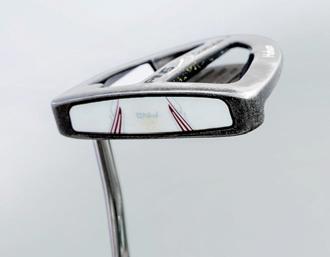
SPECS Ping Scottsdale Hohum, 36.25 inches, 3° loft, Ping Winn AVS Palmlock grip.
I started using this putter my senior year of college in 2011. It was sent to my teammate Keith Mitchell. I always played Ping since I was probably 12 years old. I started putting with it and kind of got on a heater my senior year, and it’s been in the bag since. I like my putter grip to be worn. I’ll have the Ping guys sand down a new grip to make it feel a little tacky.
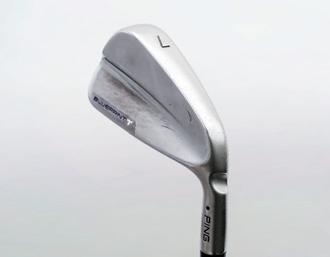
SPECS (3-iron): Ping G410 Crossover, Fujikura Atmos Black hybrid 9-X shaft; (4-9): Ping Blueprint T, True Temper Dynamic Gold Tour Issue X100 shafts; Golf Pride Tour Velvet Align grips.
I enjoy the workability of these irons with the tight pins we typically face on tour. I don’t need a big cavityback to help me get the ball up in the air. The feel is superb, too.
DUAL ALIGNMENT
The red line on the ball helps, but I mostly use the Titleist name on my Pro V1, lining it perpendicular to the putterface for aiming.
SCHOOL PRIDE
I got this yardage book at the 2019 Greenbrier event. I’d never used a yardage book before because I tend to lose things. Go Dawgs!
MONEY MARK
I used to use only a 1989 quarter to mark my ball. It represented the year I was born, but now any old quarter will do.


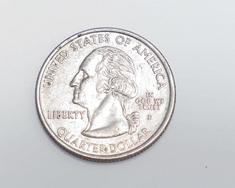







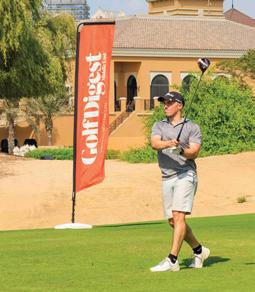







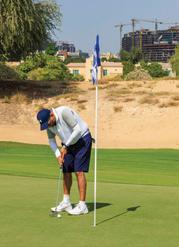


The fourth Golf Digest Middle East Oktoberfest was back again at The Els Club, Dubai – By

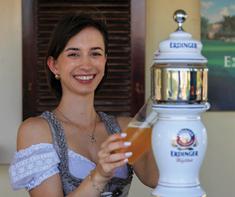















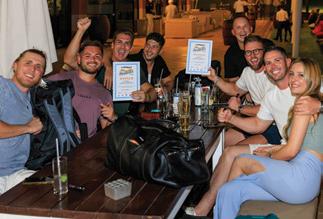

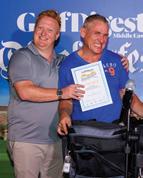
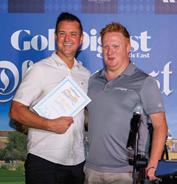
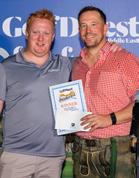


THE EVER-POPULAR Golf Digest
Middle East Oktoberfest once again took place at The Els Club, Dubai in October, for the fourth edition of the sellout Germanthemed day in what many labelled as “The best day of the year”.
The competitors were split into three divisions (Div. A 0-12 HCP, Div. B 13-24 HCP and Best Gross Score) and were in with a chance of winning some amazing prizes such as a spot in the upcoming Hero Dubai Desert Classic Pro-Am, Hero Dubai Desert Classic hospitality tickets, Emirates Dubai 7s passes, Country Club membership at The Els Club, plus plenty of other goodies from our amazing sponsors.
Taking the top prize of the Hero Dubai Desert Classic Pro-Am spot was Swiss National, Thomas Buchard with a Gross score of 70. Thomas not only will have the privilege of playing alongside some of the best DP World Tour players, but he also takes home The Els Club Country Club membership!
Topping Division A was Kevin Fearnley with an impressive 40 points to go with his two hospitality tickets for the final round
of the Hero Dubai Desert Classic, plus two season passes for the Emirates Dubai 7’s. While going two points better in Division B was Alex Augusti with 42 points. The popular social media food reviewer “Just Food DXB” was ecstatic with his two hospitality tickets for the third round of the Hero Dubai Desert Classic, and two season passes for the Emirates Dubai 7’s.
You can find all of the prize winners and their scores on the right side of this page!
A big thank you must go to The Els Club for hosting us, all the team did a fantastic job. So, a big thank to General Manager Tom Rourke and all of his team.
The course at The Els Club had hosted Tommy Fleetwood that very morning, in the season opening Lion’s Den, so there were plenty of tricky pins tucked away and the greens were nothing less than slick for our competitors. So, a big thumbs up to the greenkeeping team!
These events aren’t possible without the sponsors, so “Cheers” to Adidas, Africa and Eastern, Bakers Kitchen, Luxury Supercars and Stuart Norbury and all of his event team from Motivate Media Group.
Here’s to next year! Prost!







EDITED BY HARRY GRIMSHAW

Recently ranked as Golf Digest’s 71st World Best Golf Course, Yas Links is located in the capital of the United Arab Emirates, as it prepares to host the Abu Dhabi HSBC Championship for the third year in a row on the DP World Tour. Designed by American Kyle Phillips in 2010, eight holes play along the Persian Sea, including holes 13, 14 and 16 through 18, a most invigorating stretch. Major winners Shane Lowry, Rory McIlroy, Justin Rose, Adam Scott and two-time event winner Tommy Fleetwood are in the field for the fourth Rolex Series event of the season this November.
BY JACK BALFOUR
SI NCE THE 2023 EDITION of the Abu Dhabi HSBC Championship, 22 months have past, and one of the teams key goals was to restore the original design features of the golf course with the main focus being on bunker shaping. We have been lucky enough to work with the original designer Kyle Philips to have his input for these works.
A true links course should have the true defence from the natural elements of the wind. However, this year we will be able to present the course with more challenging areas for the players.
The thing is, it’s a real challenge to get the golf course to play as a true style of links golf, but we are fortunate with the grasses on the golf course being platinum paspalum, this can be cut super low to get the course to play firm and fast. A true style of links.
All golf courses are tough to maintain, and every course has its own unique challenges. For us growing turf in extreme conditions and looking after the staff is the real challenge, especially for this tournament as most of the preparations have been done through the hottest summer months.
There are some key changes to Yas Links, on the basis of the feedback at the DP World Tour, and they are mainly to holes 16 and 18.
The par 4 16th has had the blind bunker in the landing area reduced and is now more of a small pot bunker. As well as this the fairway has been extended on the left to encourage a risk reward style of tee shot, welcoming more of an aggressive play.
The par 5 18th has had all the ice plant removed on the left (Tyrrell Hatton will be pleased) and the fairway extended further out to the left to open up the tee shot and allow the aggressive play down the left hand side of the fairway. This has included a tee extension in doing so to give more options for the tournament setup.
Yas Links continues to evolve as a golfing destination for which our agronomy team persists to look to improve the golf course. Multiple changes continue to be tweaked with enlarging greens and reshaping of the fair-


ways and its surroundings, which continues to enhance the true links aspect of the golf course. It’s such a special place for many reasons, but mostly due to how passionate the agronomy team are about the golf course. They really feel it is theirs to protect and nurture it. With this passion, it means they are able to create great surfaces and a great golf course that challenges the best golfers in the world. We can’t wait to welcome the DP World Tour back once again!


What to look out for at the Abu Dhabi HSBC Championship BY
AMY CONDON
AS THE Abu Dhabi HSBC Championship returns to Yas Links this month, there’s a noticeable buzz among everyone here in Abu Dhabi. With the players preparing to battle it out on a course known for its rugged beauty and relentless demands, the world’s best golfers will once again be put to the test.
As a PGA Professional at Yas Links, having played the course numerous times, they never fail to deliver high drama. Here are three key holes that I believe will shape the tournament this year on the DP World Tour.
The Risk Reward
The second hole is one of my personal favourites and an early settler, if tackled correctly.
A visually striking par five at 534 yards, it dares the bold to go for the green in two but requires accuracy and good decision-making off the tee, especially with the prevailing left-to-right wind.
The risk, however, is ever-present. An ideal drive up the left-hand side over a mound may leave you unable to see your tee shot finish.
Too far left, and you’re in trouble in wasteland territory. This strategy though
takes the danger of the bunkers and raging rough up the right side out of play.
A lay-up to the right-hand side will open up the green for you, last year England’s Tyrrell Hatton made birdie from a 70-yard pitch shot on this hole. Then again, being brave and reaching it in two with the right line will give you a putt for eagle.
The green itself is incredibly undulating, with several levels clearly visible on approach. At 46 yards deep, positioning your ball perfectly on this green is important to give yourself the best opportunity for birdie.
This hole is thrilling, luring players into making decisions that could either cost or favour them early in the round.

The ninth hole is a 450-yard par four that looks picturesque, but often reveals its teeth when players least expect it.
The fairway runs along the coastline, with the wind frequently sweeping in from the Arabian Gulf, adding an unpredictable element. From the tee you
can see a narrow fairway bunker hugging the right side, with another on the left. This forces players to be accurate with their tee shots. Unless it’s downwind, players might try to bite off a little more, but the risk is significant. Mistakes here are costly, but birdies can be incredibly rewarding.
Nestled close to the shoreline, it requires pinpoint accuracy on approach shots. The green slopes away to the
back, so favouring the left-hand side on your approach is your best bet—just get it on the dance floor!
During a practice round last year, one of the pros mentioned how this hole keeps them on edge every time, and it’s easy to see why.
In 2023, several players capitalised on the favourable conditions with birdies, while others paid the price for the wind’s unpredictability.
The Penultimate Challenge
The 17th hole has a way of turning steady nerves into frayed ones, and last year was no exception. I saw several top DP World Tour players’ chances unravel here with errant shots into the water, while others took advantage of calmer conditions to stick their approaches close.
At 201 yards, this monster of a par three is nerve-wracking. The hole plays entirely over water and is surrounded by
bunkers, with a dramatically undulated green. The swirling wind from the nearby mangroves can shift directions at any moment, making this hole even tougher.
Last year, I stood to the right of the 17th green in line with the bunker when Victor Perez stepped up to the tee with the championship on the line. He had been playing solid golf all day, but the pressure of this moment was palpable. Needing to stay aggressive to maintain his lead, Perez chose a bold line over the water and his tee shot, carried by the wind, finished in the greenside bunker. However, he managed
to hole his bunker shot for birdie, a moment that ultimately secured his victory. The roar from the crowd, myself included, was deafening—a testament to how skill, nerve, and timing came together perfectly.
Not every player had such success on this daunting hole, as it became a turning point for many. Several contenders faltered under the same pressure, finding the water or deep bunkers, effectively ending their championship hopes. But Perez’s birdie here on Sunday stands out as a prime example of how champions rise to the occasion.

The second, ninth, and 17th holes will undoubtedly be where dreams are either realised or crushed. Having witnessed last year’s drama up close, I can’t wait to see how these holes shape up at the Abu Dhabi HSBC Championship this year. Whether it’s a perfectly executed drive on two, a gutsy second shot on nine, or a clutch tee shot on 17, these moments will define the champion of 2024.

hand if it’s a beautiful mountain in the distance, that may be a good thing.
It shouldn’t be a one-size-fits-all approach to the presence of trees on golf courses. We live in a big country with a lot of different environments—we’re not all one thing, so these dialogues should be taking place independently.
Architect Robert Trent Jones Jr. fields a question about the importance of trees on golf courses. Jones Jr. began designing courses with his father, Robert Trent Jones, in the 1960s and has built more than 200 in countries around the world, including Chambers Bay in Washington and Hogs Head in County Kerry, Ireland.
Golf Digest: In the past two decades there has been a major movement among architects and clubs to remove trees from their landscapes, typified by dramatic deforestations at places like Oakmont and Congressional’s Blue Course. There are valid agronomical reasons for it, but do you believe tree removal has gone too far?
Jones: Yes. When it comes to clear-cutting trees for views, it can be overdone. Superintendents have rightly been concerned about too much shade on the grass that they’re trying to maintain, and they also don’t like roots that stick up and compete for water. These are legitimate points, and they’ve gained a louder voice with the greens committees overseeing renovations. My concern is that too often the tree removal seems to be all or nothing. In some ways, it’s like our politics.
It’s better if it’s done on a case-bycase basis, but it’s currently in fashion. What usually happens in fashion is that the pendulum is always swinging, and it can swing too far. I believe in the “golden mean” of the Greeks, to find a happy medium.
If the course is in the Northeast or the South, or in parts of California where I live, it’s likely that trees are going to be native to the environment in some form and continually regenerating—that’s what nature does. On a links course there shouldn’t be any trees because they’re typically not indigenous to those types of coastal and estuary environments. They can block the wind and negate the need to play the ball along the ground, which would lessen the interest of those courses. We built Chambers Bay on an old mining site but constructed it to look and play like an Irish links, and there’s just one single tree on the course.
Most courses would do well to look whether the trees are indigenous and part of the ecological place where they’re located.
What are the benefits of maintaining existing trees on a golf course, assuming they’re native to the environment?
Jones: Trees can be useful shields. You want to ask, what do you see when you remove the trees? If it’s a garbage dump that’s probably a mistake. On the other
For an architect, trees can function like an instrument. They’re vertical hazards along with our other elements of defense: length, width, bunkers, hazards like ponds or creeks, the inviable hazard of the wind, the targets of the greens and the contours of those within. And you work with those like a composer does music to create 18 different holes while trying not to repeat yourself. I don’t believe golf courses should be made to be either hard or easy—they should be made to make beautiful music that you want to come back to, and removing any of those elements, including trees, limits the range of music you can make.













Abu Dhabi National’s “Garden Course” is getting a complete revamp by it’s original designer
BY PETER HARRADINE
FIRSTLY, IT’S NOW GOING TO be called the “Executive Course”, so I guess it used to be called the “Garden Course”.
When there are 27 holes of golf, I always try to make one set of the nine holes, an easier nine. Just to make sure it’s more suited for the “normal player”.
When I first designed the 27 holes of Abu Dhabi Golf Club back in 2000, the third nine wasn’t all that good to be called “championship”.
Overtime, it lost its character, and the new owner Khalfan Al Kaabi has decided to put some
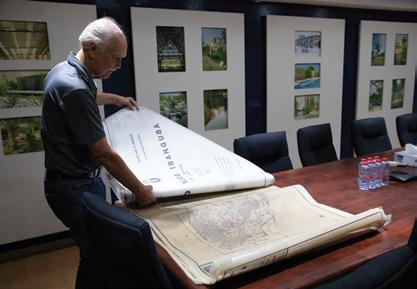



CLOCKWISE FROM ABOVE: Current state of Executive Course; The National blueprint; Designer Peter Harradine;The new Executive Course blueprint
real estate around it. And obviously, golf sells real estate, as we all know.
So currently, it’s a completely flat site. There are no lakes anymore. There’s nothing. A bulldozer has gone in there and flattened everything. There are a few trees left, fortunately. But it’s a complete new redesign. New everything, new irrigation, literally new everything.
In a way it is a lot easier to design a golf course, where you have a completely flat area, but you have to be very creative because you have to put in hillocks and all that stuff to make it exciting.
And the great thing is, here in the Gulf, the conditions are ideal for grass and they’re ideal for
good maintenance. I think that that’s what makes a difference really.
Plus, what works in our favour here, is the sand. Working with sand is great, and the weather is always good too.
We will start at a certain point and end at a certain point. So that’s already a given. Then we try to do as many different pars as possible because it’s not a very big site as it’s tree-lined and the real estate is encroaching quite a bit. So we are going to just try to make it as interesting as possible and not too difficult.
As the plans go, we’re going to do the BQ (bill of quantities) and the specs by the end of next week. And I think they want to start sometime in December to start the build. With a bit of luck, and all depending on the weather, we should be able to play in autumn 2025!




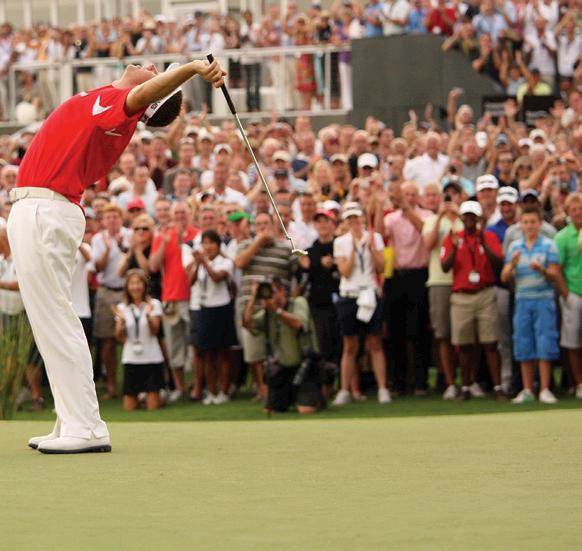




VARDON TROPHY
◀ 2023 – Rory McIlroy
2022 – Rory McIlroy
2021 – Collin Morikawa 2020 – Lee Westwood 2019 – Jon Rahm
2018 – Francesco Molinari
2017 – Tommy Fleetwood
2016 – Henrik Stenson
2015 – Rory McIlroy
2014 – Rory McIlroy
2013 – Henrik Stenson
2012 – Rory McIlroy 2011 – Luke Donald
2010 – Martin Kaymer
2009 – Lee Westwood 2008 – Robert Karlsson 2007 – Justin Rose
– Padraig Harrington
– Colin Montgomerie
– Ernie Els
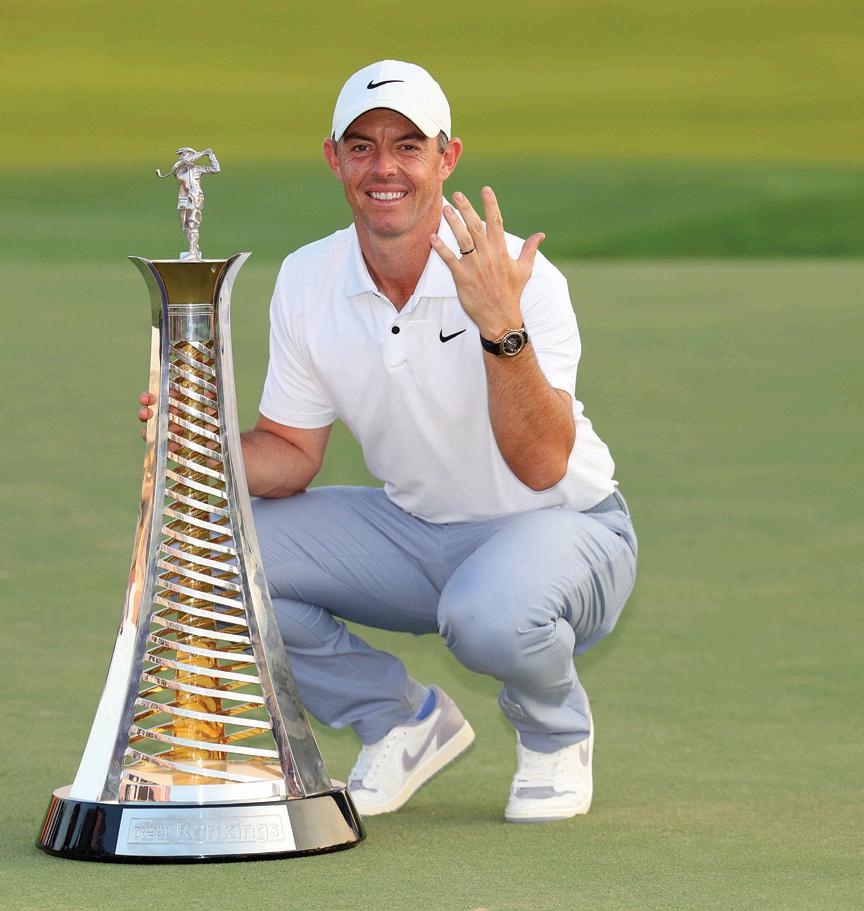


3 MULTIPLE WINNERS
8 – Colin Montgomerie 1993, 1994, 1995, 1996, 1997, 1998, 1999, 2005 6 – Seve Ballesteros 1976, 1977, 1978, 1986, 1988, 1991
5 – Rory McIlroy 2012, 2014, 2015, 2022, 2023

Charl Schwartzel (2010-Hole 6)
Ignacio Garrido (2010-Hole 6)
Joost Luiten (2012-Hole 6)
Stephen Gallacher (2012-Hole 4)
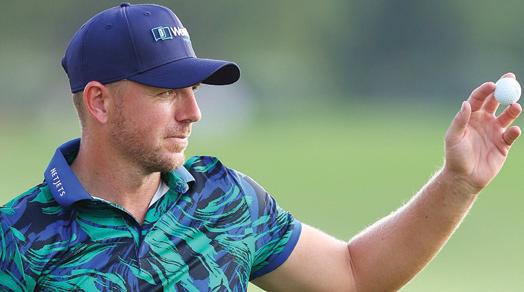
Shane Lowry (2014-Hole 3)
Francesco Molinary (2015-Hole 6)
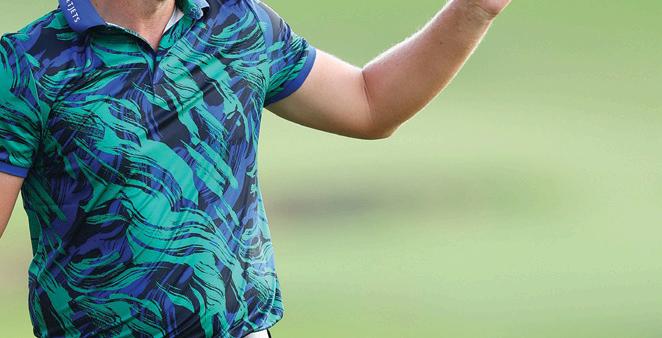
ROUND 60 (-12)
Matt Wallace (2023) Round Three (preferred lies) SIX
THE WORLD NUMBER THREE HAS HAD A ROCKY ROAD IN LEADING THE 2024 RACE TO DUBAI RANKINGS
BY HARRY GRIMSHAW
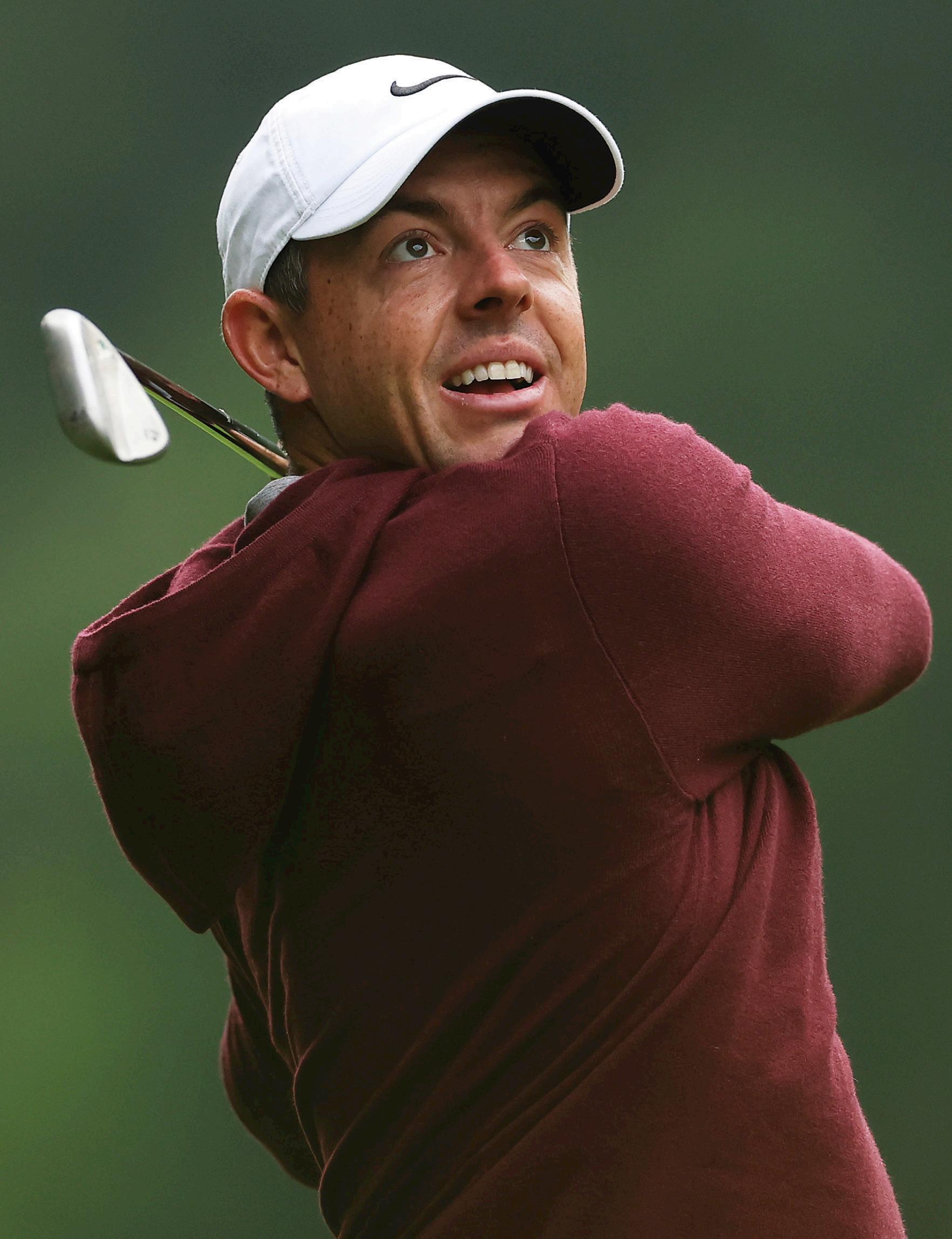
has his sights set on a record equalling sixth Harry Vardon Trophy at this year’s DP World Tour Championship, as the World Number Three heads into the DP World Tour Play-Offs with a healthy lead.
“Competing at the DP World Tour Championship is always something I look forward to at the end of the season,” McIlroy said. “Dubai has been a special place for me, and I’ve been fortunate to achieve a lot of success there. To have the chance to equal Seve’s record is incredibly meaningful, he was a pioneer for European golf, and his impact on the world game can’t be overstated.
“It’s going to be a couple of big weeks in the Middle East with the DP World Tour Play-offs and I’m focused on playing some good golf to put myself in contention for more titles.”
He might be sitting pretty sat on the summit, but it’s been a bumpy road for the 35-year-old in his 2024 passage, as he looks to equal Seve Ballesteros with six order of merit titles.
Starting off back in January, down the road at Dubai Creek Golf and Yacht Club, Rory was pipped to the post by Tommy Fleetwood in the Dubai Invitational. A near perfect start to the year.
He made up the very next week though, by mastering the Majlis with a Saturday 63 at Emirates Golf Club, en route to winning his fourth Hero Dubai Desert Classic title and leapfrog Tommy in doing so to the Race to Dubai Rankings, which he wouldn’t let go of.
After a tie for 22nd at The Masters and a T12 at Valhalla, he was trending in the right direction for a fifth major, potentially being collected at Pinehurst.
He had placed himself once again in the hot seat, in the U.S. Open and a proper Sunday showdown between Rory and Bryson DeChambeau was on the cards, but it ended in dismay for the Ulsterman who was, some might say, sitting in the best chance he had at winning his first major championship in 10 years, with just three holes left to play.
After two tentatively missed putts on the 16th and 18th at Pinehurst, Rory was sent packing and departed the premises of the Pinehurst Resort within seven minutes of Bryson’s winning putt.
Questions were being asked about Rory. This is the guy who has won the FedEx Cup three times, the Race to Dubai five times, he’s a four-time major champion, and more specifically one of three players to win four majors by age 25, joining the company of Jack Nicklaus and Tiger.
Maybe everything that Rory had been through on and off the course over the span of his career was having a dampening effect on his performances on the bigger mountains. Pressures of social media, family, LIV Golf it all adding up, to having too much on his plate.
When Rory returned back to the DP World Tour at
the Genesis Scottish Open, as defending champion, he came up four-shots short this time round, leaving his first competitive appearance since his U.S. Open nightmare in good nick.
“I had a lot of chances that I wasn’t able to convert, and that was sort of the story of the week,” said McIlroy. “There was a few scrappy bits here and there but overall, it was a good week to see where my game is heading into next week. Especially after the back of three weeks off. I’m pleased. I had one eye on trying to defend here but obviously with an eye on trying to get prepared for Troon as well.”
Maybe he wasn’t ready as he hoped to be. A Thursday seven-over 78 at The Open was his worst major round since his opening 79 at Royal Portrush in 2019 and ultimately led him with too much damage to be reversed on Friday.
The tide didn’t seem to be turning for McIlroy, which seemed to be a regular headline. A runner-up finish at Royal County Down led to an emotional moment of reflection.
* Hopefully the tide is going to turn pretty soon and I can turn all these close calls in victories
“Unfortunately, I’m getting used to it this year,” McIlroy shrugged. “Hopefully the tide is going to turn pretty soon and I can turn all these close calls into victories.”
Points mounting on his Race to Dubai lead but alas, no titles. It was similar story the very next week in the DP World Tour’s flagship event in the BMW PGA Championship, as for the second straight week he fell just short after a playoff loss to American Billy Horschel.

“Two weeks in a row, I’ve played well,” McIlroy said. “Just not quite well enough. But you know, happy with where my game is and happy where it’s trending.”
Surely, we will have a fairytale finish for Rory as he heads to the UAE with either the Abu Dhabi HSBC Championship at Yas Links or the season-ending DP World Tour Championship at Jumeirah Golf Estates in his trophy cabinet. (Alongside a sixth Harry Vardon Trophy of course).
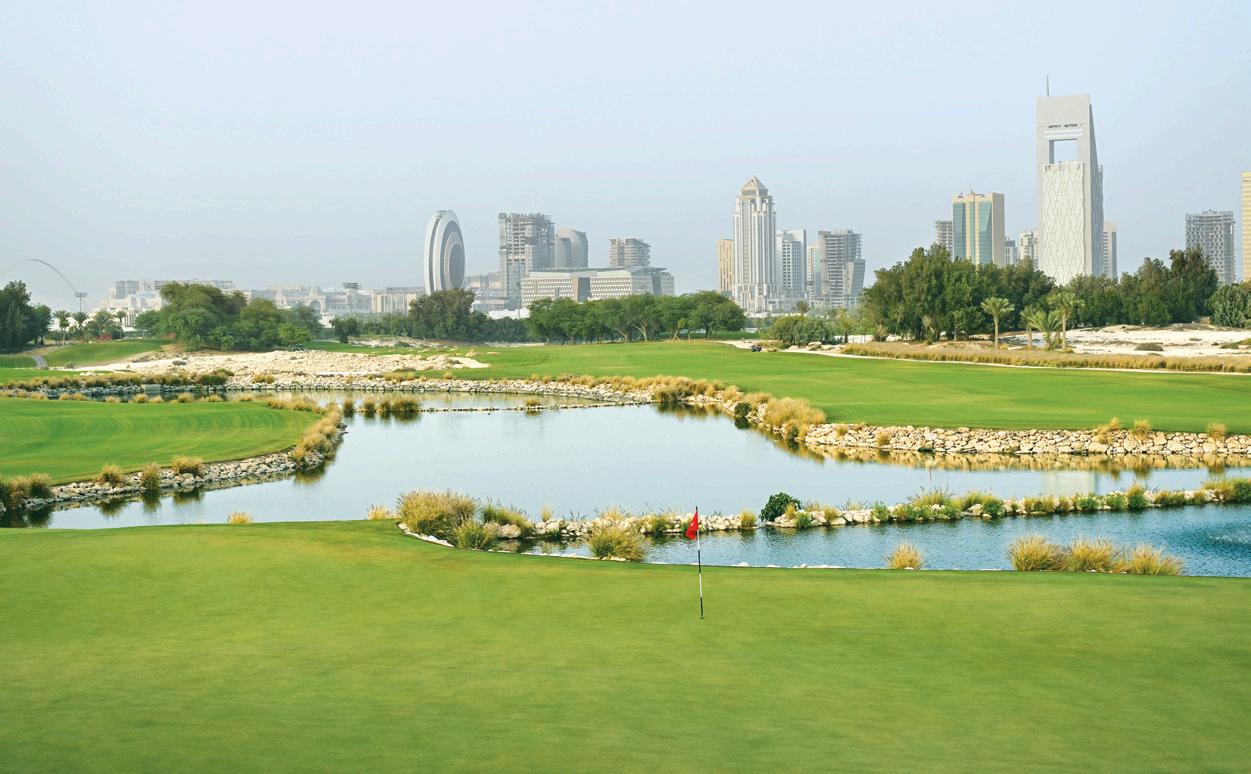
The penultimate event on the 2024 International Series schedule touches down in the Qatari Capital WITH HARRY GRIMSHAW
Afully fledged hitlist of global golfing stars have been confirmed for International Series Qatar with the likes of Dubai-based Indian Anirban Lahiri, England’s Sam Horsfield, Ryder Cupper from Belgium Thomas Pieters and American Peter Uihlein announced as just a handful of top players for the penultimate event on both the International Series and Asian Tour schedule.
They are joined by the South African quartet from LIV Golf’s Stingers GC, Dean Burmester, Branden Grace with Major winners Charl Schwartzel and Louis Oosthuizen in the US$2.5 million prize pool event, the most expensive prize fund to date on the 2024 International Series billing.
Grace is no doubt a favourite to do well around the Peter Harradine layout, having won twice here in the past on the DP World Tour in back-to-back years in 2015 & 2016 at the Commercial Bank Qatar Masters.
The 2022 LIV Golf Portland champ will have to familiarise himself with the Doha layout with its eight strategically positioned lakes, 65 giant cacti, and numerous limestone rock formations that contrast with the fairways and pale
desert, sculpted by Harradine back in the early 2000’s.
“Every time I go back to Doha, I really love it,” said Harradine. “It’s a hell of a golf course mainly because we had the rocks. The rocks make that course.
“When I was designing the course, I did calculate the wind. There are a few holes where the wind comes just straight across which makes it more difficult. On a windy day, the scores are not the same as on a day without wind.
“With a tough wind the ball rolls all by itself on the greens. They’ve actually stopped the tournament once in Doha because the greens are so fast.
“When Alvaro Quiros won in Doha back in 2009, he used to be very long, and was pretty straight for once off the tee.
“When he had his winners speech, he said ‘you know, all my colleagues are telling me the rough is too high, the rough is too high’. Well, the advice I gave them is stay on the fairway!’”
“Maybe I shouldn’t say this, but I’ll say it anyway,” said a grinning Harradine. “Doha Golf Club for me, is the best golf course in the Middle East, for sure.”
courtesy of the club




Attractions
Activities


Dining
Health
Education
Entertainment
Real Estate



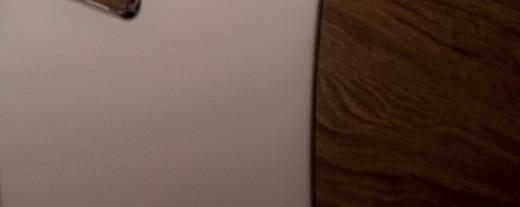
Hotels & Resorts
The







The PIF Saudi International moves to Riyadh Golf Club with a US$5million prize pool
BY HARRY GRIMSHAW

w orld number 19, Tyrrell Hatton has been announced as the latest act amongst a host of top LIV Golf stars for the US$5million 2024 PIF Saudi International, powered by SoftBank Investment Advisers, taking place December 4-7 at Riyadh Golf Club.
The season-ending tournament for both the Asian Tour and The International Series, the set of ten elevated events which form a pathway onto the LIV Golf League, is making its debut in the capital of the Kingdom of Saudi Arabia.
A seven-time winner on the DP World Tour, most recently at the Alfred Dunhill Links Championship, England’s Hatton joins the already confirmed quartet of defending champion Mexico’s Abraham Ancer, American duo of 2022 champion Harold Varner III and two-time winner Dustin Johnson, and the 2022 Open Champion Australian Cameron Smith.
Major winners Patrick Reed and Graeme McDowell, the 2020 Saudi International champion are also committed to tee it up in the Kingdom, along with Dubai-resident Adrian Meronk, a four-time winner on the DP World Tour. Spanish youngster David Puig, who is currently lying second on the Asian Tour Order of Merit will be joined by Chile’s Joaquin Niemann, the winner of LIV Golf Riyadh at Royal Greens Golf & Country Club in King Abdullah Economic City earlier this year amongst a plethora of additional LIV Golfers alongside Asian Tour legends.


I AM REALLY EXCITED TO VISIT RIYADH FOR THE FIRST TIME AND TO BE PART OF THE ASIAN TOUR’S SEASON-ENDING EVENT. –TYRRELL HATTON
Hatton commented on his announcement, “I am really excited to visit Riyadh for the first time and to be part of the Asian Tour’s seasonending event.
“I’ve been playing really well the last couple of months as my results are showing, so I really want to keep the momentum going through to the end of the year.
“I finished tied 6th when I played in PIF Saudi International in 2021, so I am hoping to be able to improve on that and finish my season on a high.”
For the first time this year, the PIF Saudi International will finish on the Saturday in order to align with the final two days with the weekend in the Kingdom as players take aim on the US$1 million first prize in the largest sole Asian Tour event on the calendar.
The tournament is the last of 10 elevated Asian Tour-sanctioned events on The International Series calendar that offer a direct pathway for play-
ers from all over the world onto the LIV Golf League. The champion of the season-ending International Series Rankings will secure a spot on the 2025 LIV Golf League roster.
In 2023, over 30 players at the top of the Rankings were eligible to play in the innovative LIV Golf Promotions event, where an additional three players qualified for the LIV Golf League. This year the 2024 PIF Saudi International powered by SoftBank Investment Advisers will be the last opportunity for players to qualify for the LIV Golf Promotions event, also to be held at Riyadh Golf Club the week after.
RORY MCILROY WILL BE GOING FOR HIS FIFTH DALLAH TROPHY AT EMIRATES GOLF CLUB IN JANUARY WITH HARRY GRIMSHAW

TThe master of the Majlis, Rory McIlroy, has confirmed his title defence at Emirates Golf Club for the Rolex Series Hero Dubai Desert Classic event from January 16-19 2025.
The four-time winner, of the Middle East’s longest-running professional golf event, will once again return to Dubai in January to kickstart his 2025 campaign on the DP World Tour.
Last January, Rory lifted the Dallah trophy for a record-breaking fourth time (2024, 2023, 2015, 2009) after coming into the weekend ten shots back, before a magical third-round 63 placed him in the final group alongside Cameron Young, as the Northern Irishman held off both the American and Poland’s Adrian Meronk for the title.
“I’m thrilled to be returning to the Emirates Golf Club for the 2025 event,” said the current Race to Dubai Rankings Number One.
“This is a tournament I relish playing and continuing my run here by adding a fifth title would be really special and an ideal way to kick off 2025.
“The support we get in Dubai is always fantastic, it’s an incredible course with a great atmosphere, and I’m looking forward to what is always a competitive event.”
The one-shot victory in 2024, confirmed McIlroy as just the second player to successfully defend their title after Scotland’s Stephen Gallacher who lifted the Dallah Trophy in 2013 and 2014, with McIlroy also passing Ernie Els’ hat-trick of Dubai Desert Classic victories.
McIlroy now has a total of six trophies in Dubai, including his two victories at the DP World Tour Cham-

This is a tournament I relish playing and continuing my run here by adding a fifth title would be really special.
pionship, as he looks to add a third one next month at Jumeirah Golf Estates.
Simon Corkill, Executive Tournament Director of Hero Dubai Desert Classic, commented on the announcement, “It’s fantastic for us that Rory is going to play. We can’t take Rory for granted.
“He’s played a lot in the Middle East, a lot in Dubai, and he’s played a lot of the Hero Dubai Desert Classics.
“He’s announced he’s going to reduce his schedule next year, so for us to get him to commit so early is fantastic.
“Rory is unbeatable pretty much
around the Majlis course, which is great and that’s why he enjoys it. I think a lot of golfers will go back to golf courses that they enjoy and play well at. But he’s the master of the Majlis and he certainly brings in the crowds.
“He’s Europe’s best player, he’s World Number Three, he’s golf’s box office hit. We’re delighted that he’s committed to play, as we say, which we can’t take for granted.”
More details on the 2025 player lineup will be coming soon in the Rolex Series event which offers a $9million prize pot.
THE 100 WORLD LEGENDS AND AL NOOR ARE WORKING IN COLLABORATION FOR A ONE-OF-A-KIND GOLF DAY







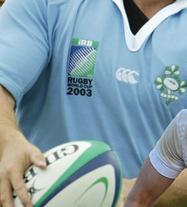




THE 100 WORLD LEGENDS, in conjunction with the Al Noor Training Centre, have come together to form a golf day like no other at Arabian Ranches Golf Club all for a special cause.
Comprised of high-profile ex-international rugby stars from over 20 countries, the 100 World Legends is an organisation whose aim is to create a lasting change to People of Determination through upholding the core values of Ruby Union. Respect for others, hard work and integrity are at the forefront as the Legends positively impact global communities through various charities, youth projects and sustainable rugbyfor-life programmes.
Working in partnership with Al Noor, the Rehabilitation & Welfare Association for People of Determination, the Centre opened its doors to Dubai on November 21st, 1981, starting with only eight children. Now the Centre serves






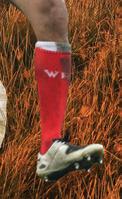

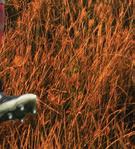
FORMAT: Texas Scamble
◼ Four-ball team including one world rugby legend. Entry fee: AED4,000
◼ Use of practice facilities from 10am
INCLUDING ONE WORLD RUGBY LEGEND FROM THE BELOW PLAYERS

◼ Includes 18 holes golf at Arabian Ranches Golf Club, 12:30 shotgun
◼ Prize presentation & BBQ buffet with beverages in Nezesaussi
over 260 children in its purpose-built facility in Al Barsha.
With global Rugby icons like Shane Byrne, Delon Armitage, Tamara Taylor and Colin Charvis already confirmed for the day. Guests will be competing in a four-ball alongside one Rugby Legend.

Colin Charvis (Wales/Lions)
Lee Mears (England/Lions )
Shane Byrne (Ireland/Lions)
Serge Betsen (France)
Tamara Taylor (England Womens Team)
Apollo Perelini (Samoa)
Norman Maxwell (New Zealand)
Charles Riechelmann (New Zealand)
Ofisa Tonu’u (New Zealand)
Delon Armitage (England)
Gareth Widdop (England/GB League)
David Corkery (Ireland)
Terry Bourahua (France)
Bruce Reihana (New Zealand)
Chris Masoe (New Zealand)
Sam Tuitupou (New Zealand)
Fergus Thomson (Scotland)
Bryan Redpath (Scotland)
Aaron Persico (Italy)

We y everything - Heavy-lifters, CineFPV, DJI, Helicopters and produce Drone Light Shows
We produce - Drone Light Shows and 3D Models for Digital Twins and Virtual Production



MAKE THE SKY YOUR CANVAS, BOOK US NOW








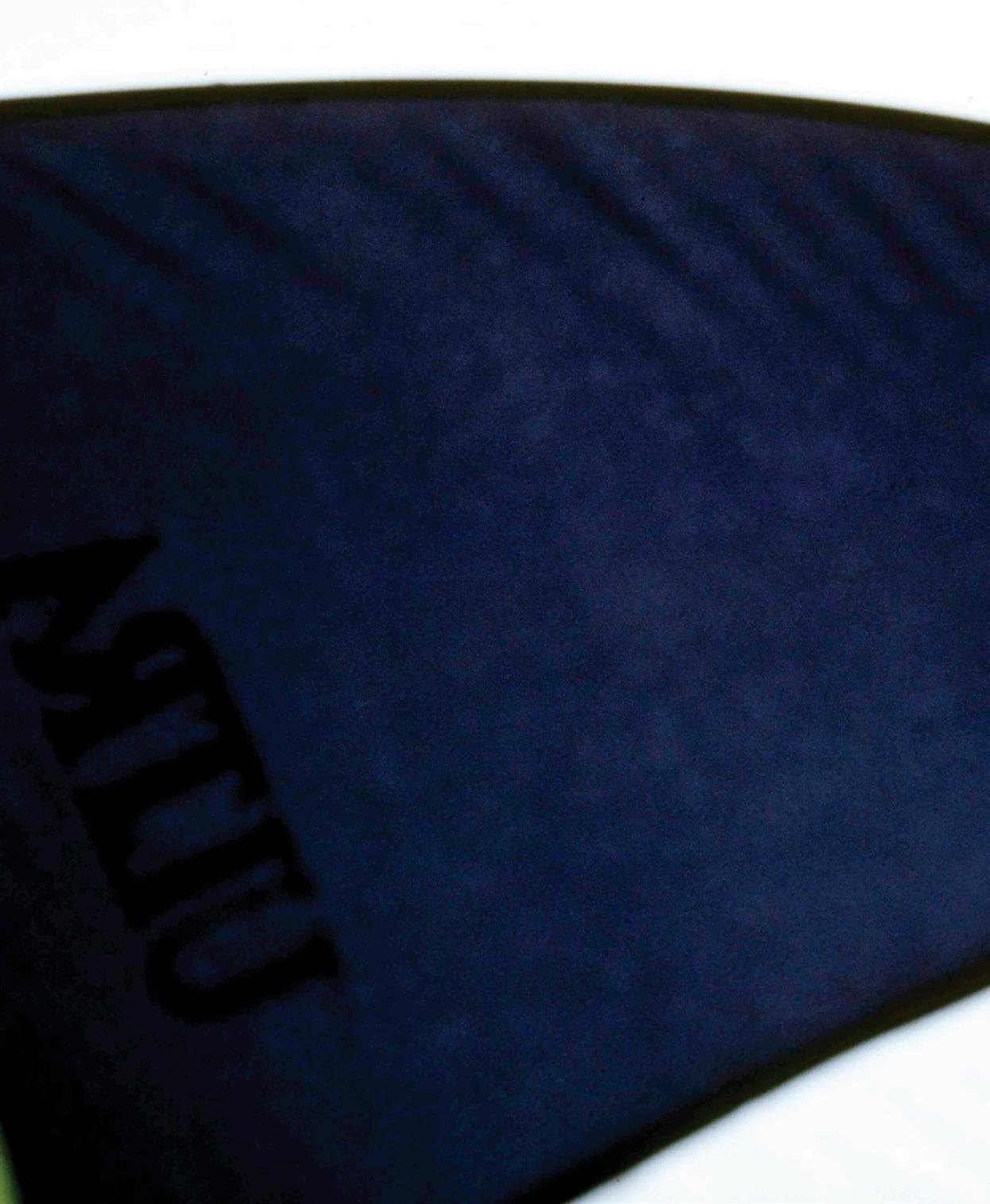














TWENTY-FIVE YEARS AFTER THE GOLFER’S PASSING, A WRITER REMEMBERS UNGUARDED TIMES


BY GUY YOCOM



The neighbourhoods around Bay Hill Club in Orlando are notoriously maze-like, and on a March morning in 1999, I couldn’t find Payne Stewart’s house. He lived just off the 12th tee of the course, and I’d been to his home before, but somehow was looking on the wrong side of the street. Suddenly a barefoot guy in shorts and a t-shirt sprang into the street and slapped the hood of my rental car, waving his arms and yelling as though warning of a washed-out bridge. It was Stewart, of course, as theatrical and extroverted as you saw on TV. When Stewart comes to mind, I don’t see the celebration when he holed the putt on the final hole at Pinehurst to win the 1999 U.S. Open. I see that snippet of him in his natural habitat three months earlier, waving his arms and laughing as he shouted through my rolled-up window, “Right here, dummy!”
Interview gold came from Stewart that day, as it always did with him, and I left thinking I’d hang with him many more times. But a few months and his best career exploits later, he was gone. It’s been 25 years since the Learjet 30 carrying Stewart and five others—pilot Michael Kling, 42; first officer Stephanie Bellegarrigue, 27; course architect Bruce Borland, 40; Stewart’s agent, Robert Fraley, 46 and one of Fraley’s colleagues, Van Ardan, 45— plunged into a field near Mina, South Dakota. It
occurred on Oct. 25 after a catastrophic loss of cabin pressure not long after takeoff. They were traveling from Orlando to Dallas, where Stewart was consulting on a course design in nearby Frisco. From there they were headed to Houston for the Tour Championship. All likely were rendered unconscious within a minute or so, and the plane drifted north and eventually ran out of fuel. It stands as the saddest moment in golf. That Stewart was happily married to Tracey, his wife of 18 years, and had two wonderful children— daughter Chelsea, 13 and son Aaron, 10—made the tragedy even more heartbreaking. Media coverage was extraordinary, with national TV networks interrupting daily programming to cover the episode live well before the plane crashed. Jim Nantz, then as now a CBS sports broadcaster, hustled from a restaurant in Connecticut to New York City to assist in reporting for the network. The immediate aftermath was morose but inspiring, the long-term appreciations stunning and prolonged. Stewart’s funeral in Orlando five days later was attended by many of the most noteworthy people in golf. Jackie Burke, the great golf sage who passed away at 100 earlier this year, once said, “Live your life so that when you die, you fill up the church.” First Baptist Church in Orlando was packed that day. Eight months later, at the 2000 U.S. Open
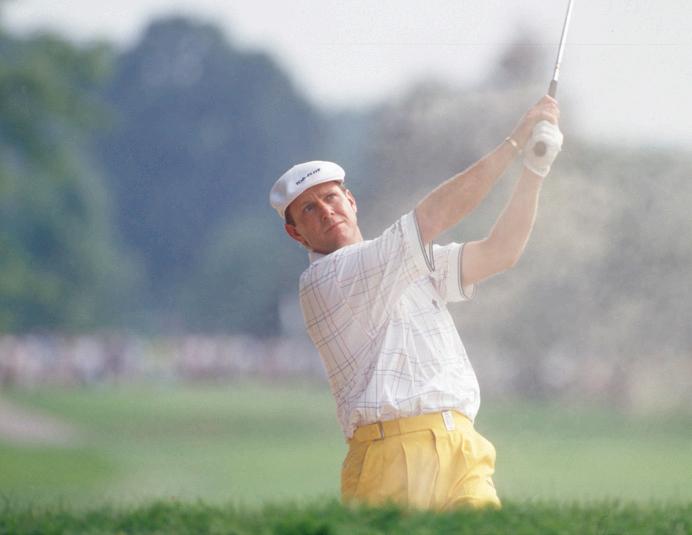
at Pebble Beach, some 40 tour pros simultaneously blasted drivers into the Pacific Ocean in tribute. Documentaries, books and dozens of articles followed. We saw plenty of tributes to Stewart during the U.S. Open at Pinehurst earlier this year—and more will follow.
We’re still talking about Stewart, and it sometimes feels like he’s still here but standing just off stage. It’s important to remember that a whole generation knows him only by reputation and highlights on YouTube. The Stewart catalogue thankfully is substantial. He was known for his gorgeous, old-school, athletic swing; the explosive, knickered outfits that sometimes looked elegant; the spontaneous, one-of-a-kind reactions when a big putt fell; the furious gum-chewing; the sawed-off Missouri twang; the physicality when he hugged his children or his caddie, Mike Hicks; and the way he cradled Phil Mickelson’s face after defeating him at Pinehurst. Stewart was as distinct as any player who ever lived and a truly exceptional one. He won three majors, the 1989 PGA Championship and the U.S. Open in 1991 and 1999. He won 11 PGA Tour titles overall, played on five U.S.

Ryder Cup teams and finished second in two British Opens. We wonder what he would have done had he been able to keep going. That long swing and ageless flexibility suggest great things, but he also had three degenerative disks in his lower back and an enlarged heart. It’s a mystery, but fans certainly would have paid good money to find out. Stewart was, as the late writer Dan Jenkins frequently pointed out, a “ticket seller.” He put butts in the seats. He made the game better. Who was Payne Stewart, really? I had several longish sits with him over the years. Not enough to become close but enough to where he would deliberately bump into me and knock me off balance and then say, “Oh, I’m so sorry.” The last visit in 1999 was the most revealing, and I’ll reference it because it mirrors the impressions of others. He demonstrated both tremendous hospitality and simple generosity. When we talked about his latest outfits, he showed me his closet, a mini-department store packed with shirts, shoes, hats and a long row of knickers. “You want a pair?” he asked. I stupidly declined. When we talked about music— his beloved set of harmonicas and performances with buddies Peter Jacobsen and Mark Lye in their novelty group, Jake Trout and the Flounders—he quickly dashed off to get a CD for me. That, I accepted. He also offered to make lunch. He just liked to give people stuff. When Stewart won at Bay Hill in 1987, his first tour victory in more than three years, he donated his entire $108,000 check to Florida Hospital (now AdventHealth Orlando). His love of family really came out the day of my visit. Daughter Chelsea was gone that day, but Aaron was around, and Stewart called him over, made small talk and tousled his hair. Stewart told him to look me in the eye when he shook my hand. Tracey was there, too, but she was mostly out of sight. Vin Scully, the great Dodgers announcer who for years also did golf telecasts, told me the one golf image that affected him most was Stewart stopping alongside the 12th hole during tournament play to dash over and give Chelsea a hug. Payne spoke a lot about his father, Bill Stewart, a fine player himself who dressed brashly and played in the 1955 U.S. Open. When Payne entered a USGA event, his dad insisted he write his full name—William Payne Stewart—on the entry form. Payne, by the way, went by “Bill” when he played in the 1974 U.S. Junior Amateur. He spoke fondly of his two older sisters, Lora and Susan, who roughhoused with him when he was young to toughen him up. Payne could cook, sew and iron, but he was no pretty boy. He was a vicious competitor and was notorious at sporting events for the abuse he hurled at coaches and players. He also spoke of his mother, Bee, and told of the intervention the family had done with her years earlier. After Payne passed, she at age 81 ran for the Missouri House of Representatives.
Stewart in 1999 was very open about his small addictions—he liked his drinks (“two or three or four”), not to where it was a serious problem but
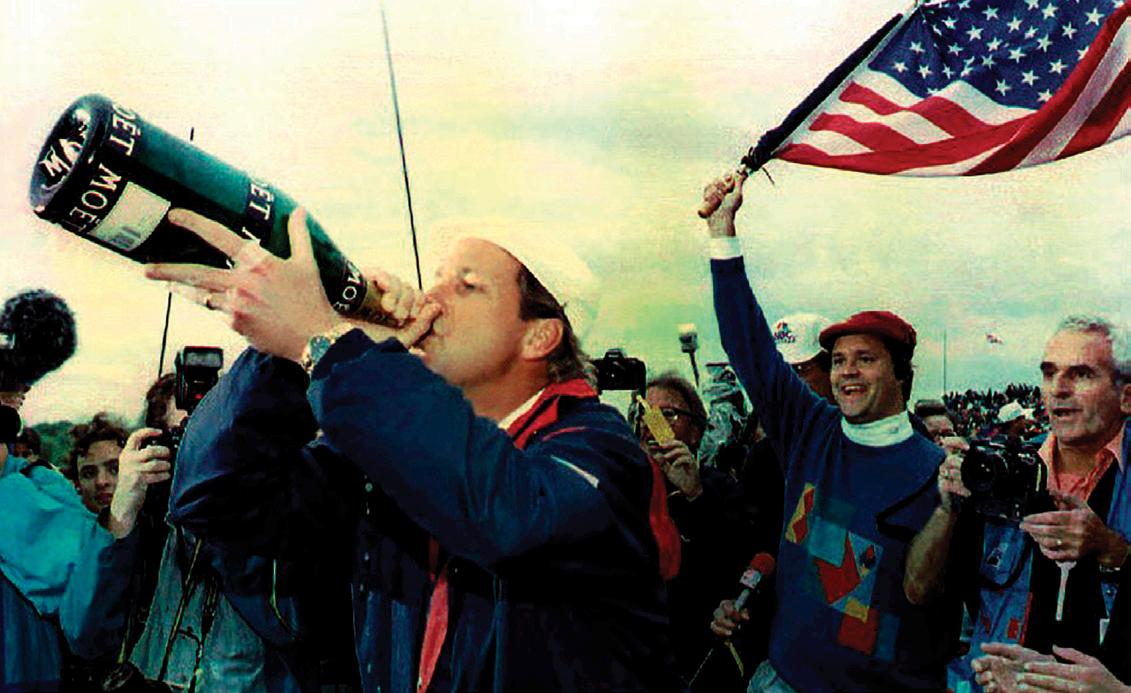
didn’t leave him feeling good. Socially he loved cigars, the occasional cigarette and Skoal chewing tobacco. He was talking about how he was off and on with all of it but was in the process of quitting. Moments later he spied the round outline of a tobacco tin in my front pocket. He looked around like a kid about to swipe a candy bar and whispered, “Break it out.” He loaded up, sighed with pleasure and then said, “We need to quit this.”
Stewart that day was critical of the PGA Tour about the same issues players complain about today. He wanted bigger purses and more money for players who made the cut. He wondered aloud about transparency, finances in general and tour officials’ private jets in particular. That was 25 years ago. If Stewart were alive, would he have gone to LIV? There’s a theory that guys who cry during the national anthem don’t go to LIV, and Stewart was a patriot who welled up every time. So, no, but there’s little doubt that commissioner Jay Monahan would be getting some tough love.
He talked of his moodiness, brought on by streaks of underachievement and his ongoing battle with ADD, which wasn’t diagnosed until 1995. Stewart possessed great charm but also could be snappish and cutting. Starting in 1985, when I’d hit him up for instruction tips and golf conversation, he was a blast. He’d finished third in the 1984 National Long Drive—his swing masked remarkable power—and Golf Digest presented the event, so he was deferential. Then he entered a threeyears-plus period in which he won twice but lost five tournaments in playoffs. Writers dubbed him,
“THERE’S A THEORY THAT GUYS WHO CRY DURING THE NATIONAL ANTHEM DON’T GO TO LIV, AND PAYNE WAS A PATRIOT WHO WELLED UP EVERY TIME.”
“Avis,” the car-rental company which touted its second-place status in the industry in an ad campaign, which irritated him to no end. “You writers have the pen, and you buy your ink by the gallon,” he groused. Another lousy streak from mid-1991 to ’99, brought on by an equipment change, made him even less fun to be around—but he got better.
FOR COUNTRY
Hoisting a magnum of champagne after the U.S. Ryder Cup win at The Belfry outside London in 1993.
The ADD made him hard to play with. One former PGA Tour caddie told me of the time Stewart was jingling change in his pocket while his player was preparing to putt. He knew Stewart, knew the jingling was only an absent-minded ADD thing and walked over to him and said, “Payne, how old are you?” Stewart answered, “Thirty-four. Why?” The caddie said, “A little old to be jingling change, right?” Stewart was embarrassed and apologised. He was a great sportsman, and film exists of him charging into the gallery at the 1999 Ryder Cup to demand that fans who were abusing Colin Montgomerie be ejected. He conceded a putt to Montgomerie on the last hole that day—a putt that gave Monty the win, not a tie.
After his victory at Bay Hill in 1987, he posed on a Golf Digest cover with a chimpanzee named Deena hugging him from behind. “How Payne Stewart Got the Monkey Off His Back” was a bestseller and his mother’s favourite image of him. The chimp took a curious liking to Stewart. Our photographer, Steve Szurlej, remembers delivering the chimp and her trainer to the shoot and Deena fooling with the car keys in the ignition and gear shift while the car was running. One of the first things Stewart asked during my 1999 visit was, “How’s Deena doing?” I told him I had no idea. Stewart had a long memory.
Stewart’s legend wouldn’t be near what it is without him being a superb player. Johnny Miller envied Stewart’s medium-high ball flight, Arnold Palmer pined for Stewart’s rhythm, and Lee Trevino, who felt that every great player had at least one weakness somewhere through the bag, made an exception for Stewart. “That kid has the whole package,” he said. To stand near Stewart on the range and watch him hit balls—to hear him hit balls because the sound of impact seemed louder than most players—was a treat.
He was at his best playing hard courses, and he relished bad weather, two marks of a great player. Watching the replay of him that misty Sunday at Pinehurst in 1999, when he scissored the arms off his rain jacket to give him more freedom, reminded me of a 1989 quasi-instruction cover piece I ghosted for Stewart. It was titled “Cold, Wind and Rain.” He said that as a kid he played even when it snowed and spoke of the golf ball growing as it collected snow on the greens. He talked about dressing in layers, an obvious photo op. I assumed the first layer would be a pair of Spandex long johns, but Stewart emerged from
WARM HUGS
Stewart posing for a 1987 cover story, and with his family (Chelsea, Aaron, and wife, Tracey).


the changing room wearing only briefs. “Absolutely no way we’re shooting that,” I said. “But it’s the first layer,” Stewart protested. An endearing thing about him was his utter lack of self-consciousness, be it apparel, speech or his unabashed harmonica playing.
Aaron, now 35, graduated from Southern Methodist University and captained the golf team. He became a marketing executive for Hilton Grand Vacations and tournament director of its namesake event on the LPGA Tour. He married and became the father of two children. Chelsea, 38, also married and is the mother of two. It’s a fun irony that one of Bill Stewart’s last bits of advice to son Payne was, “Only have two children.” Payne and Tracey did it that way and so have their kids—so far, anyway. Tracey never remarried but, with Chelsea and Aaron, appears for the annual presentation of the Payne Stewart Award presented by the PGA Tour.
In a beautiful documentary on Stewart titled “Payne,” Tracey Stewart said that years before the plane crash, Payne bought her mother a beautiful wristwatch. Both of her parents were staying with the Stewarts on the morning of the accident and were visiting Epcot Center when the awful news arrived. “That morning at 9:30, her watch stopped,” she said. “It was 9:30 when they would have perished.”
Everything stopped that morning for so many people, but it’s amazing how time eases heartbreak so that it isn’t the chief thing that filters through. Stewart’s victory celebration at Pinehurst—and that snippet of the wild character running into the street at Bay Hill—just makes me smile.













Editor’s note: The following is excerpted from the new memoir The Unconquerable Game: My Life in Golf and Business by Ely Callaway. Ely Reeves Callaway founded the golf-club company in 1982 after successful careers in textile and winemaking. He died in 2001 at age 82.
hen Callaway set out to reimagine the driver in the late 1980s, we knew we needed to create something radically new that would significantly improve average golfers’ chances of hitting a good shot with their generally not-too-good swing. We needed a club with a larger sweet spot that remained stable at impact (particularly for off-centre hits), allowing the player to make more mistakes—a club that was forgiving. The problem was fundamentally one of physics: We needed to make our existing driver-clubhead design 25 percent bigger but not heavier (otherwise it would be too cumbersome to swing and more likely to break). We were willing to gamble that if we did that, we’d have a more satisfying club that would sell at a profit.
We did not originate the oversized clubhead. Hisamitsu Ohnishi, the executive director of our Japanese distributor, Sumitomo, and one of the great figures in golf in Japan, had introduced us to an oversized driver called the Yonex. This club was big in Japan, and Ohnishi thought it might do well to add this type of design to Callaway’s repertoire. We liked the idea, but after three weeks of trials, we determined the Yonex was not as good as our S2H2 driver. It didn’t feel as good, and it didn’t perform as well. Still, the idea of an oversized clubhead was promising. This was a critical moment: We could take the safe route and simply make an American knockoff of the Yonex and sell it right away or spend a lot of time and money finding ways to improve it. Some say it’s best to be first, but that’s a myth. Being first is always short lived. The key is to be first and the best. We chose to take our time and make the best. Fortunately for us, nobody else was interested in oversized clubheads, so we were going to be first no matter what.
Our first problem was that the Yonex had a graphite head. Graphite was a composite material of carbon fiber and epoxy that could be stretched easily but was prone to scuffing and caving in. We thought, Let’s try to make it out of stainless steel instead, which is a stronger metal that could better hold its shape. A steel head would require developing a whole new casting technology—a technique to stretch the walls thin enough to make it big but sturdy enough to hold up on impact. I called up Jack Welch, CEO of General Electric, and told him about this hot new idea we had and asked if anybody in his R&D department could lend us a hand. Welch said, “Let me put you in touch with my aircraft department.”
My design team, led by Dick Helmstetter and our toolmaker, Glenn Schmidt, with help from GE’s science and technology people, crafted a new mold that could produce 100,000 stainless-steel clubheads without serious deterioration. Usually, the more you made, the more the quality of the heads would deteriorate over time, particularly with the size we were attempting. This mold cost twice as much as a regular mold, but in the long run would be cheaper and make a better clubhead.
I didn’t want to see any of this new technology or new designs until they were done, not even a drawing. I’m not a technical person, and I can’t visualize anything, so I didn’t want to see anything halfway through. All I wanted to see was the finished product so I could take it out and use it. Dick plopped down the first oversized stainless-steel clubhead on my desk in the summer of 1990. It wasn’t that big, but it was bigger than normal at the time. It was also ugly, but it pleased me in a way I couldn’t quite put into words. I told Dick to stick the head on a shaft so that we could take it for a spin.
Dick and I tested our new driver that weekend at The Vintage Club in Indian Wells, California. The first time I swung it was on the 10th hole of the Mountain Course. I hit my first shot off the tee down the middle of the fairway. That was good, but it wasn’t the clincher: On my second shot, I hit the driver off the fairway, and the ball fired directly to the pin. As good a player as I was, I could not hit this kind of shot from the fairway. The trajectory as it rose into the air was more like a tee shot than an approach shot—it felt like it had been propelled out of a cannon rather than ricocheting off the club face.
Because of this feeling, the name of our new driver came to me almost immediately. It was not uncommon for people to name golf clubs after weapons—Spalding came out with a series of clubs called The Cannon in the mid-1980s. I remembered a reference book on artillery from my days in the army during World War II. There was one image of a giant World War I German howitzer invented by Friedrich Krupp AG, the largest weapons manufacturer in Germany. The reference book claimed this cannon shot artillery shells further and straighter than any other. German soldiers had bestowed the cannon with a peculiar nickname.
I often went golfing with my son, Nicholas, and I brought the new Callaway driver to the Del Mar Country Club one weekend, hoping I might impress him. I told him, “Nicky, we’re gonna bring out a new golf club next year, and this is the first prototype. It is going to change the game of golf. I’ve even given it a name. Would you like to know what it is?”

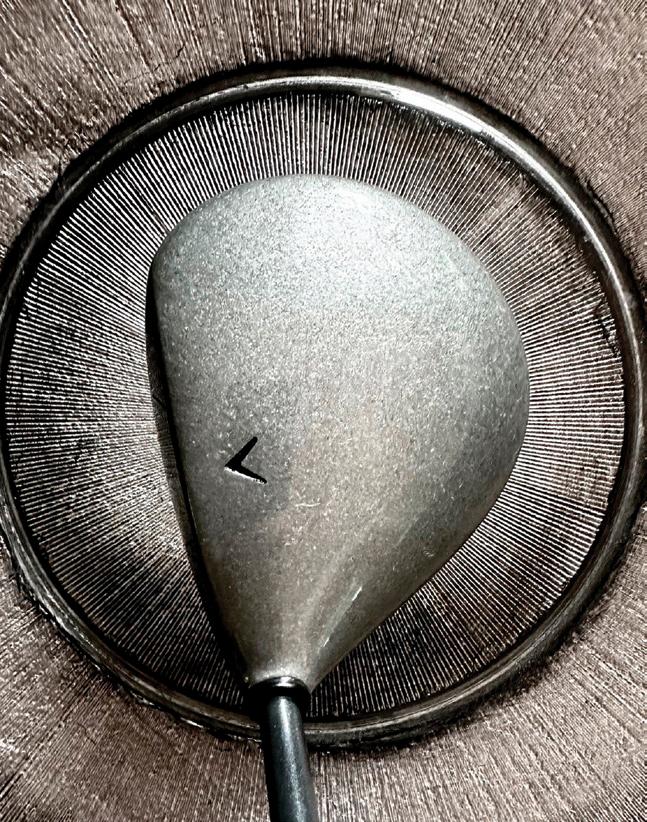
He said, “Sure, lay it on me.”
“I’m gonna call it Big Bertha.”
Nicholas shot back, “Dad, that’s the worst name for a product I’ve ever heard.”
I replied, “Well, you’re wrong, for two reasons. First, it’s a great name because it has a story behind it: the World War I German cannon! Second, just remember: The product makes the name, the name doesn’t make the product.”
Nicholas retorted, “I still think it’s a terrible name.”
To make the clubhead bigger but not heavier, we stretched the stainless-steel perimeter walls like blowing up a balloon. This had the unintended consequence of making our driver sound like an empty Campbell’s Soup can every time you struck the ball.
The sound seemed like a disadvantage. Every player knows that sound on impact is key. Or maybe they know it but don’t know they know it.
We worked hard to preserve that classic persimmon sound. First, we filled the heads with foam so they wouldn’t sound so hollow, but the foam made the club heavier, causing our shafts to continually break. We then tried lighter foam, but that deteriorated within the
clubhead after only a month. We had many problems, but they were the kind of problems you run into when you’re trying to do something nobody has ever done before. The only question was whether the problems were going to kill the promise.
Eventually, I decided to get rid of the foam in part because of the weight problem but also because we decided we liked the sound of the early Big Berthas better. We were selling a whole new type of club; why should it sound like an old one?
We got the final factory samples of Big Bertha around Christmas 1990, with clubheads a whopping 190 cubic centimetres. It wasn’t just that it was bigger. By putting more weight around the clubhead’s perimeter, we enlarged the sweet spot compared to persimmon drivers. Our designers used our patented S2H2 technology to eliminate the neck of the club by extending the shaft through the clubhead, creating more energy at impact. We tested them at Bear Creek in Temecula, California, next to where I lived, and at The Vintage Club. The Big Bertha performed so beautifully, we just hit balls indiscriminately into the desert for sheer pleasure.
When you’re releasing a new product, you have to predict how many you’re going to sell for the first six months of the next year so that you can decide how many to fabricate and what the lead time must be and how much money you will risk on inventory. Starting from scratch, it took 26 weeks to get a clubhead after placing an order with the foundry. You don’t go down to the corner store and ask for 10,000 Big Bertha clubheads and get them within two weeks. Someone suggested we order 40,000, but I said, “No, we’re going to order 60,000,” which at the time was a huge commitment. No customer had tried the club or even seen it, but still we ordered 60,000 clubs.
The original Big Bertha driver debuted in 1991 at 190 cubic centimetres.
We bet the farm on Big Bertha. Each club cost about $25 to $30 to produce, instead of the usual $12. We spent $2 million producing these funny-looking, oversized sticks. We had a feeling our casting technique would hold up to 500 clubheads before the mold deteriorated, but 60,000? We really had no idea. Meanwhile, the head of the casting plant was a heavy drinker and ran us all nuts. We couldn’t kill him, we couldn’t fire him, and we couldn’t ignore him: We just had to work around him. Hasn’t everybody encountered that kind of person in their workplace?
After we placed the order but before we debuted Big Bertha, the General Electric Pension Fund heard about
*I told them the name was Big Bertha, and that’s the way it was. Few people rebelled against Jack Welch, but I didn’t give a damn what Jack Welch thought.
this promising new club and wanted to have a meeting. Dale Frey told us how excited they were about our new product. “Now, we know you name everything,” he said, “and I hear that you’re going to name it Big Bertha, and we’re wondering whether or not that’s the best name.”
I said, “Well, we think it is. Have you got a better one?”
He said, “No, no, it’s just that some of us think it might not be the best.”
“Some of us who?”
“Well, me, and John Myers and Jack Welch.”
Well, that’s a powerful group right there, but they didn’t have a substitute, so I told them the name was Big Bertha and that’s the way it was. Very few people rebelled against Jack Welch, but I didn’t give a damn what Jack Welch thought, and I told Dale Frey just that. Now, you can’t do that unless you have a record of achievement or unless you’re very foolish, but my record of achievement was such that I could reasonably take a position, and say, well, I’m going to do things my way.
Despite my bold prediction to Nicholas, I didn’t know exactly how good Big Bertha was, or if it would even be successful. No matter how much confidence you have, there’s no real way of knowing until a product is used by the customer. We didn’t really do any market research, either, at least not in the traditional sense. Why would we? If I had gone to consumers in 1991 and asked them whether they would buy a driver that was 25 percent bigger than the one they already had, looked different from anything they’d ever hit, was priced twice as high as any driver they’d ever paid for, made a peculiar sound on impact, and had a funny-sounding name, they would say no, so we didn’t ask them! We wanted to do it, and we knew that if we did it right, the customers would buy it and be delighted.
We debuted the Big Bertha at the PGA trade show in Orlando in January 1991. We didn’t do much advertising because we couldn’t afford it. Instead, we designed our campaigns to create a maximum splash. During the week of the trade show, we took out a full-page ad in the local North Florida edition of The Wall Street Journal. Our sales staff hand-delivered the paper to every hotel room in town on the second day of the show. Because nobody notices whether it’s a local edition, these people thought they were seeing an expensive national ad. With brain power, a few sore backs, and a little money, we got a lot of high-priced exposure on the cheap.
Callaway held a press conference to discuss our revolutionary new club, and I made sure to put Jack Welch beside me at the table. I asked him to stand up and accept some recognition for helping develop Big Bertha. He hadn’t really done much, but he was our money, and it’s never a bad idea to let your money feel good about itself. Three years before, our S2H2 irons had established us as a company to be reckoned with, but that was nothing compared to the enthusiasm with which the industry greeted Big Bertha.
Big Bertha was one of those products, of which
*Within one week of the trade show, before a single consumer had spent a cent on a club, pros on the PGA, Senior and LPGA tours were teeing off with Big Bertha.
there are very few, that lit a fuse and took off like a rocket. We had fretted over our initial order of 60,000. We should have ordered 150,000. Within weeks of the trade show, before a single consumer had spent a cent on a club, professionals on the PGA, Senior and LPGA tours were teeing off with Big Bertha. President George Bush, Bill Clinton, Sean Connery, Jack Lemmon and most of the CEOs and corporate executives at the AT&T Pro-Am had a Bertha in their bag. Within a year it became the best-selling golf club in the world, favoured by tour pros and hackers alike. Our sales that year leaped to $54 million. During that first year, we ran three print ads and not one second of television ads. It was all word of mouth.
Once we sold through our initial stock, it took us the better part of three and a half years to catch up with demand. The Big Bertha catapulted us from a small golfclub company into a behemoth. It also kicked off the age of stainless-steel drivers and oversized clubheads, an arms race of bigger heads and lighter metals that would continue into the 21st century.
What Callaway accomplished with Big Bertha can be done in any business. Think of how the Internet and email changed personal computing, or how Amazon popularised online shopping. Suddenly an aspect of the game that perhaps felt too advanced for the common man became widely accessible, even beloved. It isn’t that hard to do. The problem is that most people don’t make up their minds to do it.

Printed by permission from the upcoming book The Unconquerable Game: My Life in Golf and Business by Ely Callaway. Scheduled to be published in print, e-book and audiobook on March 24, 2025, by Callaway Arts & Entertainment ($40). Copyright © 2025 by Nicholas Callaway.
A gallery of some of the local winners in the amateur circuit. Spot anyone you know?!
















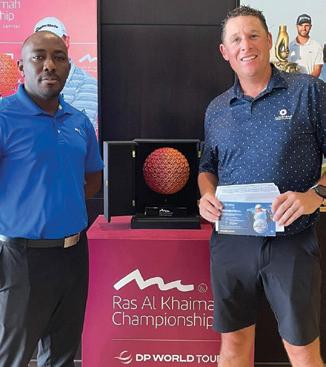






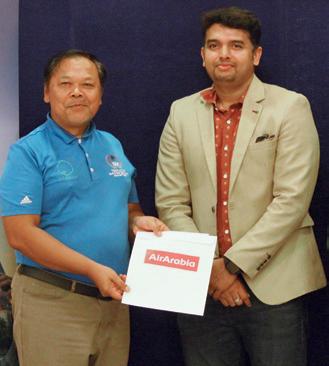









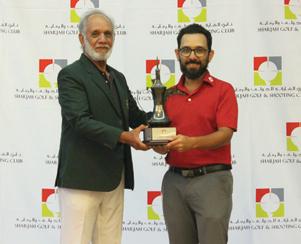








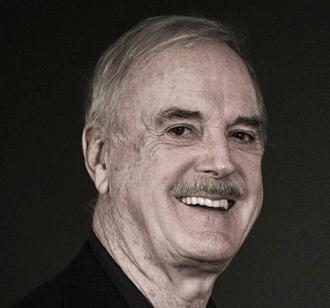
























WITH BRITTANY ROMANO
TUMI ALPHA INTERNATIONAL DUALACCESS CARRY-ON
I always travel with an average-size suitcase, a carry-on and my golf bag. I try to keep it light on the outbound and don’t pack too much because I typically add things as I go, so I like to leave room for more.
My packing list for a typical tournament week is about 12 to 15 golf polos, five pairs of shorts, 10 pairs of pants, two to three pairs of golf shoes. I always roll up my clothes as it creates more space in my bag, but then my clothes get wrinkly, so I iron everything when I get to the hotel. If I’m packing shorts, I’ll always make sure to pack ankle socks. I like to play golf in high socks but never wear high socks with shorts.
I keep it casual when packing for o the course. I always have a pair of Adidas Ultraboost sneakers with me, at least one pair of originals—usually Stan Smiths—and probably a hoodie (Adidas Originals Trefoil), another favourite.
I like to bring my iPad Mini because it’s perfect for watching movies and shows. I also normally have a book in my bag, even though I don’t always read. I tend to fall asleep on the plane, but if I have the energy to read, I will.
It’s easy to get dehydrated while flying so I like to drink a lot of water and co ee. I also keep a packet of Liquid I.V. in my carry-on to make sure I get some vitamins
When I get to the airport, I look for the healthy stu , which isn’t always an easy thing to find. Chipotle is great because it is so quick and good for you, and you can create your own meal. My go-to order is what’s called a Double-Wrapped Burrito. You get two tortillas, and I load up with black beans, brown rice, chicken, guac and some veggies—the works.
One thing I always have on me is floss because I really hate when things get stuck in my teeth.































4 - 7 DECEMBER 2024






















